Connecticut, nestled in the northeastern region of the United States, experiences a diverse array of wildlife throughout the year. As the biting cold of winter blankets the state, a remarkable transformation takes place in the avian world.
With the arrival of this frosty season, an ensemble of winter birds migrates to Connecticut to seek refuge from the harsh conditions of their breeding grounds further north.
These resilient and captivating creatures bring a splash of color and life to the wintry landscape, offering bird watchers and nature enthusiasts a unique opportunity to witness their fascinating behaviors and adaptations.
In this article, we will explore the diverse species of winter birds that grace the state of Connecticut, shedding light on their incredible survival strategies and the importance of protecting their habitats.
From the iconic snowy owl to the charming dark-eyed junco, let us discover the enchanting world of winter birds in Connecticut.
49 Winter Birds In Connecticut
Connecticut, with its diverse habitats ranging from coastal areas to dense forests, hosts a variety of bird species during the winter. Here are 49 winter birds you might encounter in Connecticut:
1. House Sparrow (Passer domesticus)
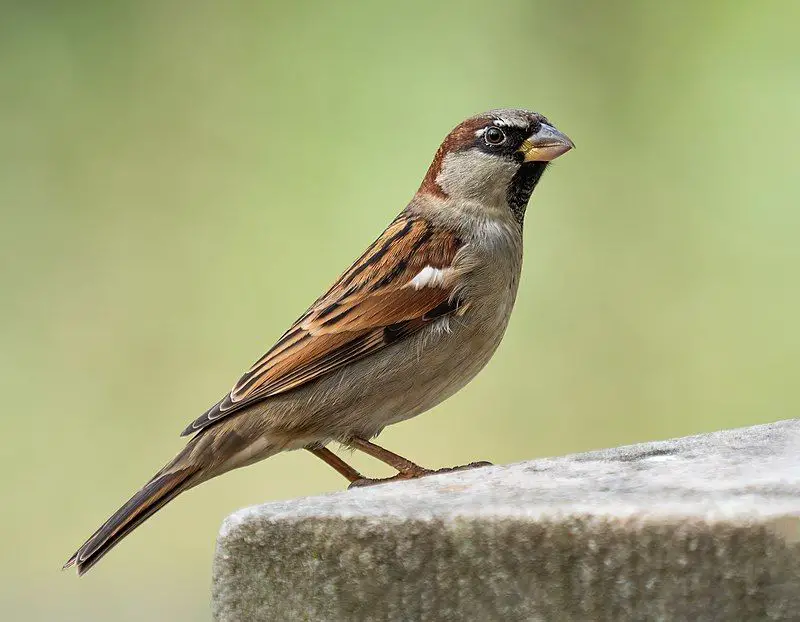
The House Sparrow is a small, robust bird, measuring about 6-6.7 inches in length. It’s a familiar sight in urban and suburban areas. Males have a distinctive appearance with a gray crown, white cheeks, a black bib, and a rufous neck.
Females and juveniles are more muted in color, primarily brown and gray with streaking on the back. They are not native to North America, originally from Europe and Asia, but were introduced in the late 19th century and are now widespread.
House Sparrows are adaptable and often found near human habitations. They have a varied diet, including seeds, insects, and food scraps.
| Kingdom | Animalia |
| Phylum | Chordata |
| Clade | Dinosauria |
| Class | Aves |
| Order | Passeriformes |
| Family | Passeridae |
| Genus | Passer |
| Species | P. domesticus |
2. American Goldfinch (Spinus tristis)
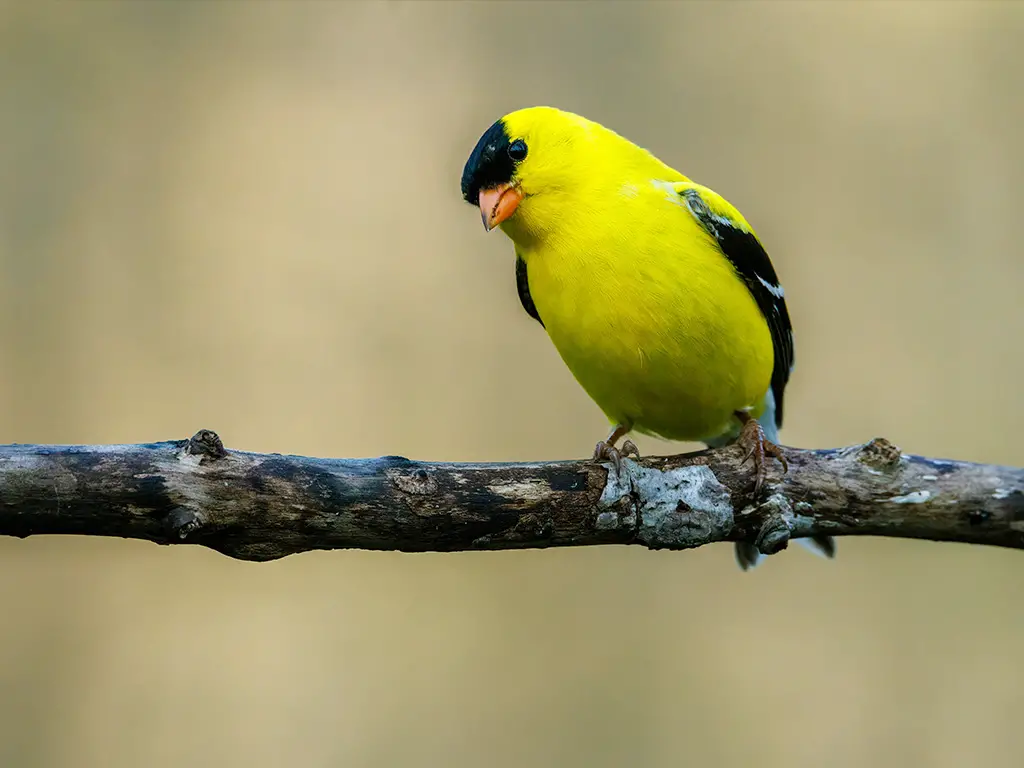
The American Goldfinch is a small, vibrant bird, measuring about 4.3-5.1 inches in length. Males in breeding plumage are bright yellow with a black forehead, black wings with white markings, and a white rump.
Females and non-breeding males are more olive-brown. They are commonly found in open fields and gardens, feeding mainly on seeds, especially from the composite family, which includes sunflowers and thistles.
The American Goldfinch is known for its undulating flight and cheerful, twittering song. It’s also the state bird of New Jersey, Iowa, and Washington.
| Kingdom | Animalia |
| Phylum | Chordata |
| Clade | Dinosauria |
| Class | Aves |
| Order | Passeriformes |
| Family | Fringillidae |
| Genus | Spinus |
| Species | S. tristis |
3. Downy Woodpecker (Dryobates pubescens)
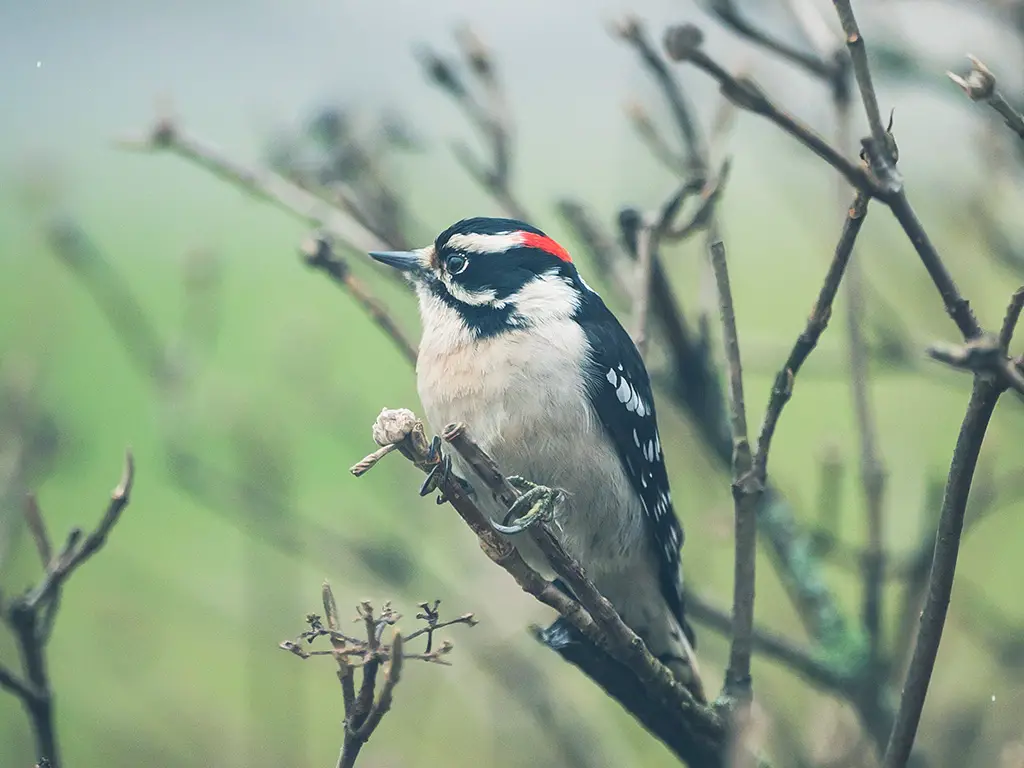
The Downy Woodpecker is the smallest North American woodpecker, measuring about 5.5-6.7 inches in length. It has a black and white checkered pattern, with a white back, throat, and belly.
Males have a small red patch on the back of their head. These birds are found in a variety of habitats, including forests, woodlands, orchards, and parks.
They feed on insects, sap, berries, and grains, and are known for their ability to cling to tree trunks and branches while foraging. Their presence is often announced by their high-pitched pecking on trees and their sharp “pik” calls.
| Kingdom | Animalia |
| Phylum | Chordata |
| Clade | Dinosauria |
| Class | Aves |
| Order | Piciformes |
| Family | Picidae |
| Genus | Dryobates |
| Species | D. pubescens |
4. American Robin (Turdus migratorius)
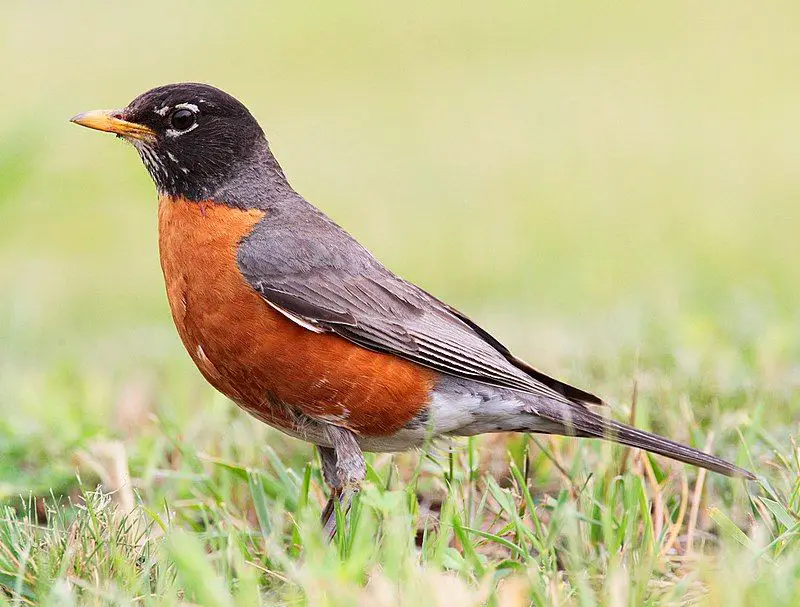
The American Robin is a familiar and widespread bird, measuring about 9-11 inches in length. It is easily recognized by its warm orange underparts, contrasting with its dark gray to black head and back.
The bill is yellow, and the tail and lower back are white-tipped. Robins are often seen hopping across lawns, gardens, and fields, where they hunt for earthworms, insects, and fruit.
They are known for their melodious songs, often heard at dawn and dusk. American Robins are considered harbingers of spring in many parts of North America and are a common sight in both rural and urban settings.
| Kingdom | Animalia |
| Phylum | Chordata |
| Clade | Dinosauria |
| Class | Aves |
| Order | Passeriformes |
| Family | Turdidae |
| Genus | Turdus |
| Species | T. migratorius |
5. House Finch (Haemorhous mexicanus)
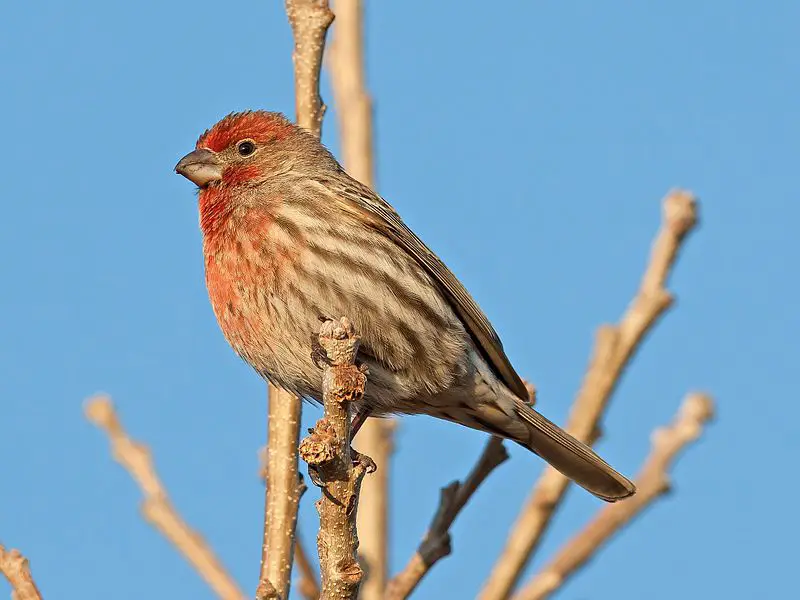
The House Finch is a small, cheerful bird, measuring about 5-6 inches in length. Males have a striking redhead, throat, and breast, although the red can vary to orange or yellow in some birds. The rest of their plumage is brown and streaked.
Females lack the red coloring and are generally brown and streaked overall. Originally from the western United States, these birds were introduced to the eastern states and have adapted well to urban and suburban environments.
They are often seen at bird feeders and are known for their pleasant warbling song.
| Kingdom | Animalia |
| Phylum | Chordata |
| Clade | Dinosauria |
| Class | Aves |
| Order | Passeriformes |
| Family | Fringillidae |
| Genus | Haemorhous |
| Species | H. mexicanus |
6. Red-Bellied Woodpecker
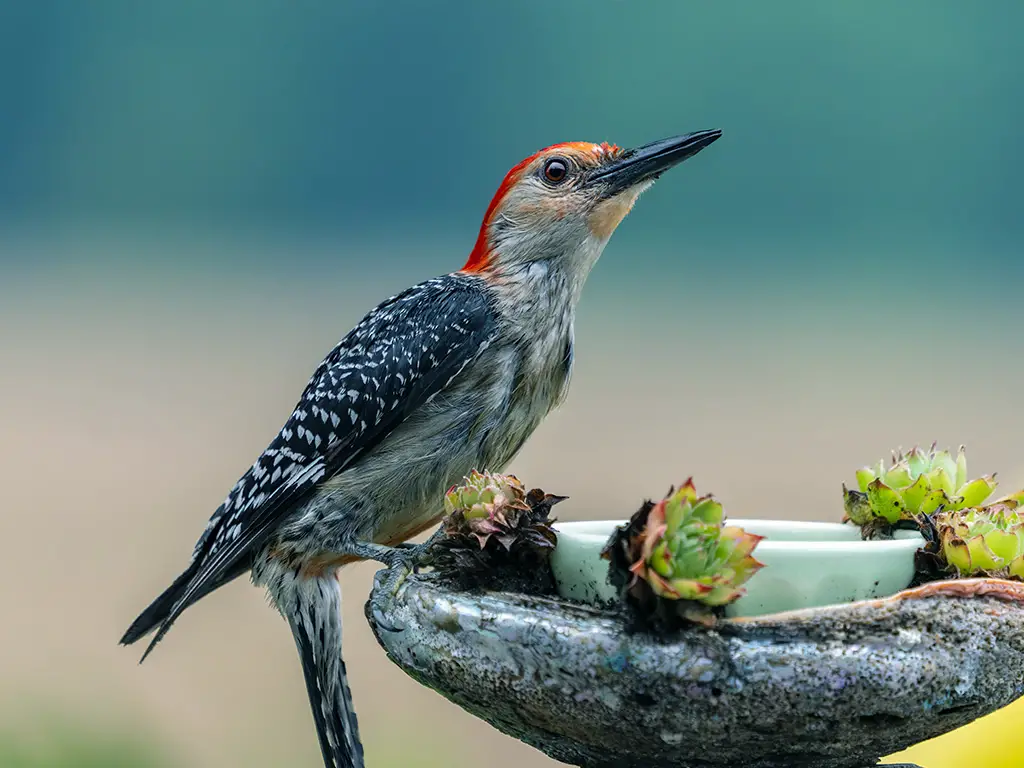
The Red-Bellied Woodpecker is a medium-sized woodpecker, measuring about 9-10.5 inches in length. Despite its name, the most noticeable feature is the red cap and nape on males; females have a red nape but a gray crown.
The belly is subtly tinged with red, often difficult to see. Its back is barred with black and white. They are common in woodlands, gardens, and parks, known for their loud call and drumming on trees. They feed on insects, fruits, and nuts.
| Kingdom | Animalia |
| Phylum | Chordata |
| Clade | Dinosauria |
| Class | Aves |
| Order | Piciformes |
| Family | Picidae |
| Genus | Melanerpes |
| Species | M. carolinus |
7. Woodpeckers (General)
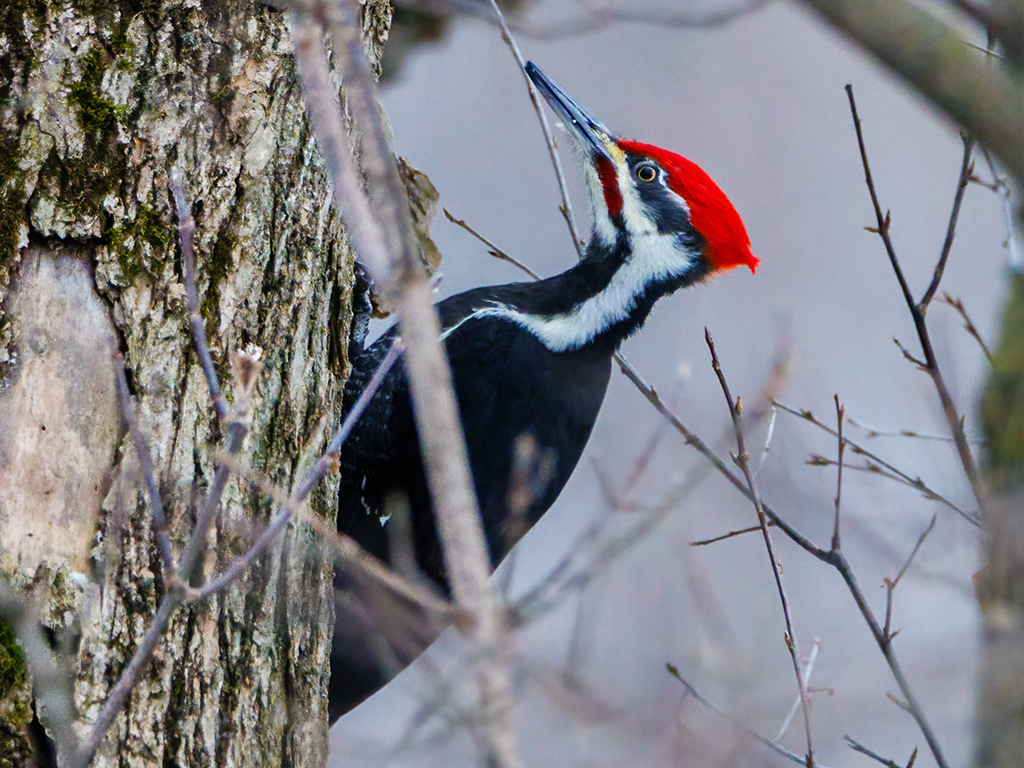
Woodpeckers are part of the family Picidae and are known for their unique ability to peck into wood with their strong beaks. This behavior helps them find insects to eat and create cavities for nesting.
They generally have strong tails used for support against tree trunks, pointed beaks, and zygodactyl feet (two toes pointing forward and two backward) for climbing.
Their size, plumage, and behavior vary among species. Woodpeckers play a crucial role in ecosystems by controlling insect populations and creating nesting sites for other species.
| Kingdom | Animalia |
| Phylum | Chordata |
| Clade | Dinosauria |
| Class | Aves |
| Order | Piciformes |
| Family | Picidae |
8. Blue Jay (Cyanocitta cristata)
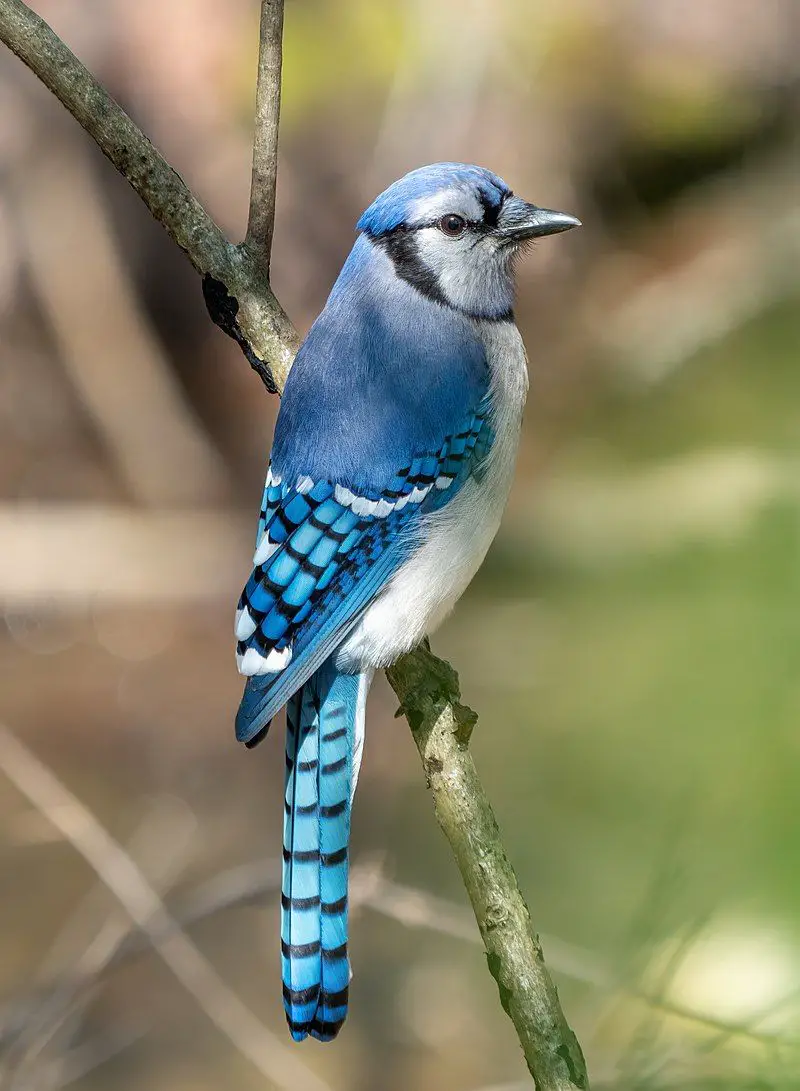
The Blue Jay is a large, vibrant bird, about 9-12 inches in length. It is easily recognized by its bright blue upperparts, white underparts, and distinctive blue crest on the head.
It also has black markings around the neck and a broad, black band on the wings and tail. Blue Jays are known for their intelligence, complex social systems, and a wide variety of calls, including excellent mimicry of other bird species. They feed on nuts, seeds, insects, and occasionally small vertebrates.
| Kingdom | Animalia |
| Phylum | Chordata |
| Clade | Dinosauria |
| Class | Aves |
| Order | Passeriformes |
| Family | Corvidae |
| Genus | Cyanocitta |
| Species | C. cristata |
9. Black-Capped Chickadee (Poecile atricapillus)
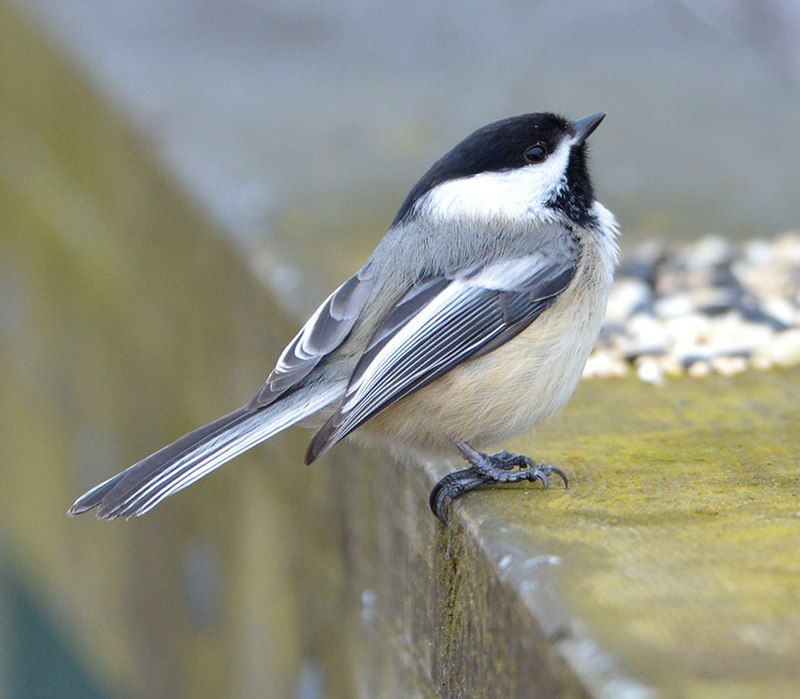
The Black-Capped Chickadee is a small, charming bird, about 4.5-5.5 inches in length. It has a distinctive black cap and bib, white cheeks, gray back, wings, and tail, and fluffy, buff-colored underparts.
These birds are curious and sociable, often approaching humans closely. They are known for their cheerful “chick-a-dee-dee-dee” call, which can change in intensity depending on the level of threat from predators.
Black-Capped Chickadees feed on insects, seeds, and berries and are common visitors to bird feeders in their range.
| Kingdom | Animalia |
| Phylum | Chordata |
| Clade | Dinosauria |
| Class | Aves |
| Order | Passeriformes |
| Family | Paridae |
| Genus | Poecile |
| Species | P. atricapillus |
10. Common Starling (Sturnus vulgaris)
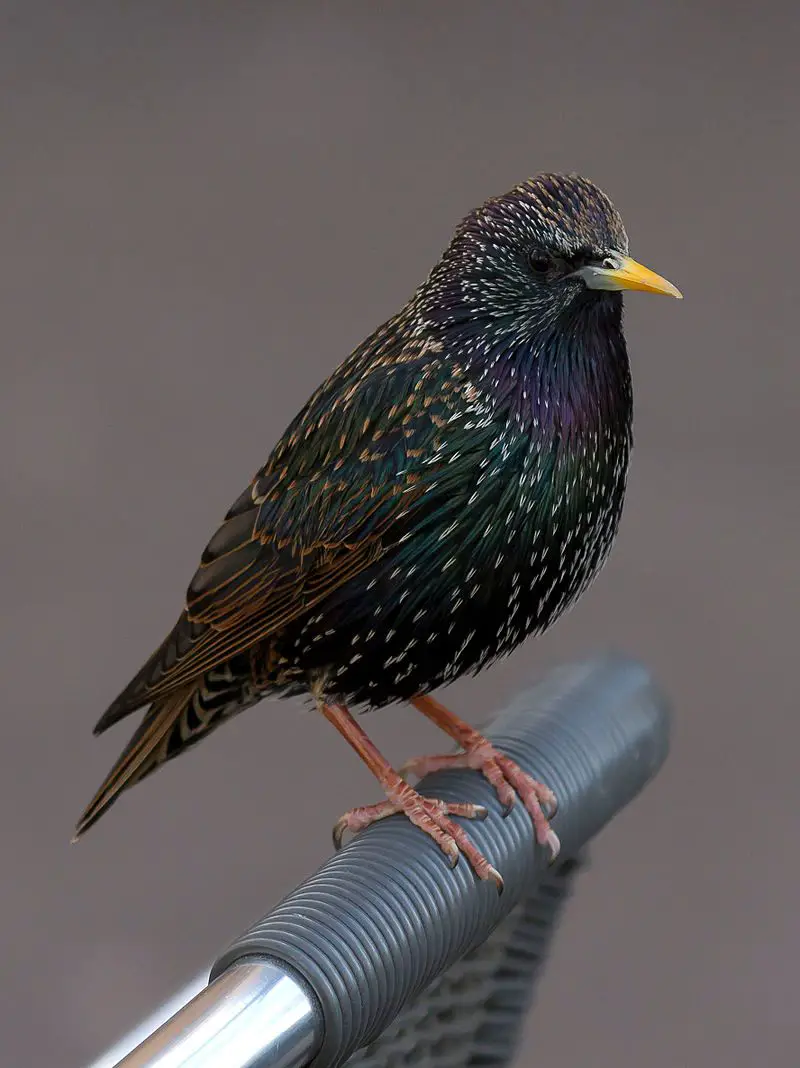
The Common Starling, scientifically known as Sturnus vulgaris, is a medium-sized bird native to Europe and Asia. Characterized by its iridescent plumage, it displays a glossy black appearance with white spots during the breeding season.
This bird has a distinctive ability to mimic sounds, often imitating other birds and even mechanical noises. Common Starlings are highly social, often forming large flocks, especially during migration.
Their diet consists of insects, fruits, and seeds, making them adaptable and opportunistic feeders. Their remarkable murmurations, where thousands of birds fly in synchronized patterns, are a breathtaking natural spectacle.
While they are considered pests in some regions due to their impact on crops, their adaptability and vocal prowess make them an intriguing species.
| Kingdom | Animalia |
| Phylum | Chordata |
| Clade | Dinosauria |
| Class | Aves |
| Order | Passeriformes |
| Family | Sturnidae |
| Genus | Sturnus |
| Species | S. vulgaris |
11. Dark-Eyed Junco (Junco hyemalis)
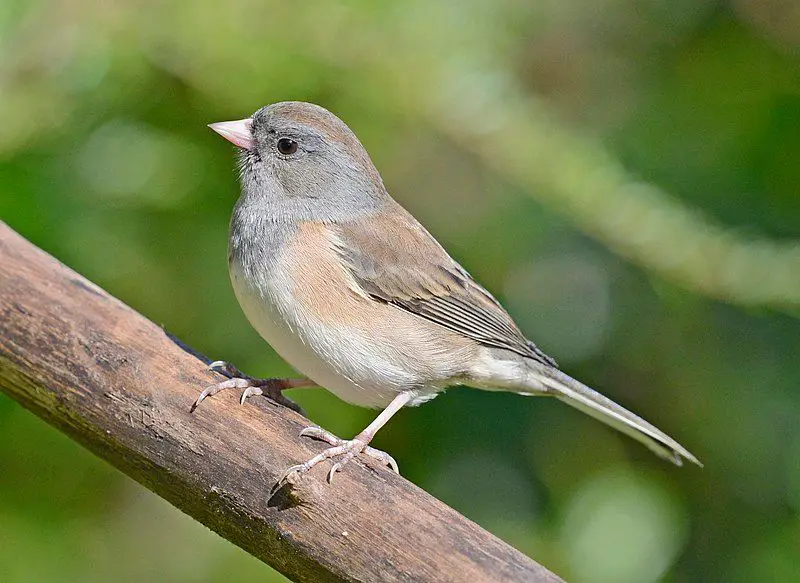
The Dark-Eyed Junco, Junco hyemalis, is a small, migratory sparrow found throughout North America. These birds exhibit a striking variation in plumage, but they generally feature a slate-gray body with a white belly and a conspicuous dark hood or “eyebrow.”
Dark-Eyed Juncos are well-known for their winter presence in many backyards, where they forage for seeds on the ground. They prefer coniferous and mixed woodlands during their breeding season, building cup-shaped nests on the ground.
They primarily feed on seeds, insects, and small invertebrates. These adaptable birds are a common sight in colder regions and have distinctive regional variations, making them an interesting subject of study for ornithologists.
| Kingdom | Animalia |
| Phylum | Chordata |
| Clade | Dinosauria |
| Class | Aves |
| Order | Passeriformes |
| Family | Passerellidae |
| Genus | Junco |
| Species | J. hyemalis |
12. Mourning Dove (Zenaida macroura)
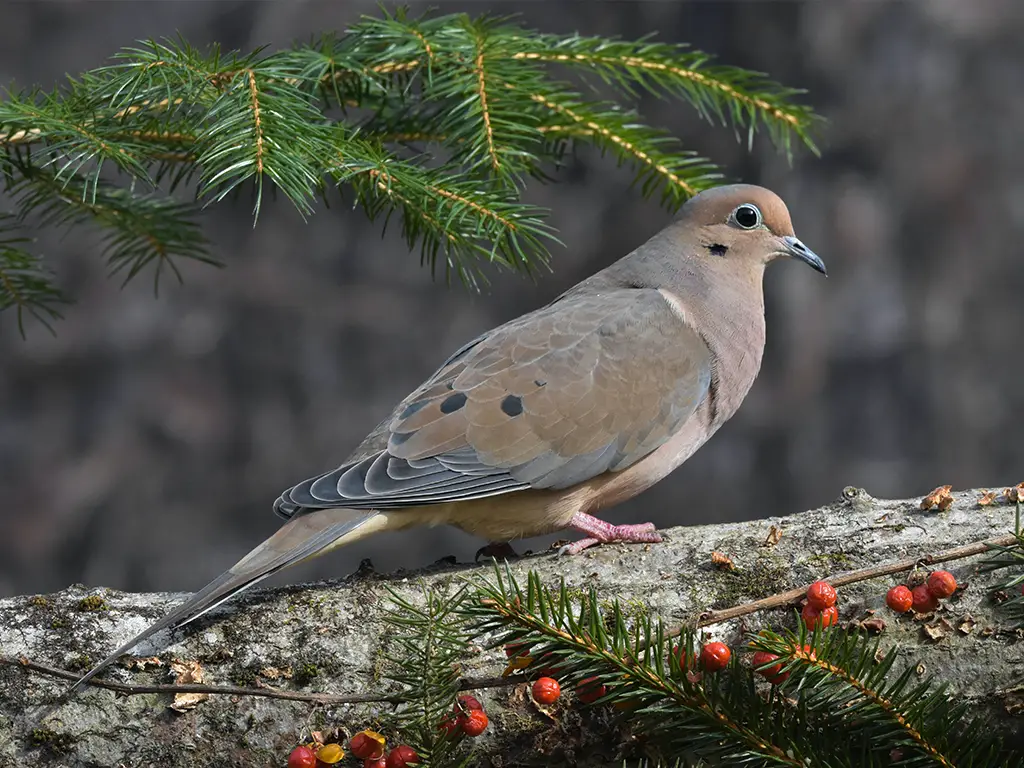
The Mourning Dove, Zenaida macroura, is a gentle and widespread bird found across North and Central America. Recognized by its soft, mournful cooing call, these doves are characterized by their delicate, muted coloring.
They possess a light grayish-brown body with a pinkish hue on their chest. Mourning Doves are versatile and can adapt to a variety of habitats, including urban areas, farmland, and open woodlands. They primarily feed on seeds, particularly those of grains and grasses.
Their monogamous breeding pairs often build flimsy nests in trees or on ledges. These doves have a relatively short lifespan in the wild but are abundant and important contributors to the ecosystem, as they help control weed populations and serve as prey for various predators.
| Kingdom | Animalia |
| Phylum | Chordata |
| Clade | Dinosauria |
| Class | Aves |
| Order | Columbiformes |
| Family | Columbidae |
| Genus | Zenaida |
| Species | Z. macroura |
13. Song Sparrow (Melospiza melodia)
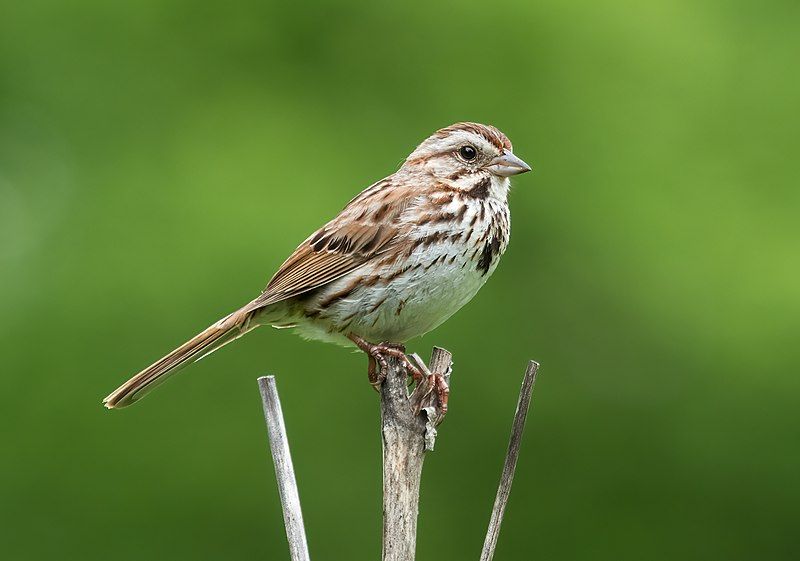
The Song Sparrow, Melospiza melodia, is a widespread bird species found throughout North America. These sparrows are known for their melodious and varied songs, which are a familiar sound in gardens and woodlands during the breeding season.
Song Sparrows exhibit considerable variation in plumage, but they generally have brown streaked bodies with a prominent central breast spot.
They prefer habitats such as shrublands, grasslands, and wetlands. Their diet consists of seeds, insects, and small invertebrates.
They build nests in dense vegetation, and their adaptability to urban environments has led to their frequent presence in suburban gardens, making them a favorite among birdwatchers.
| Kingdom | Animalia |
| Phylum | Chordata |
| Clade | Dinosauria |
| Class | Aves |
| Order | Passeriformes |
| Family | Passerellidae |
| Genus | Melospiza |
| Species | M. melodia |
14. White-Breasted Nuthatch (Sitta carolinensis)
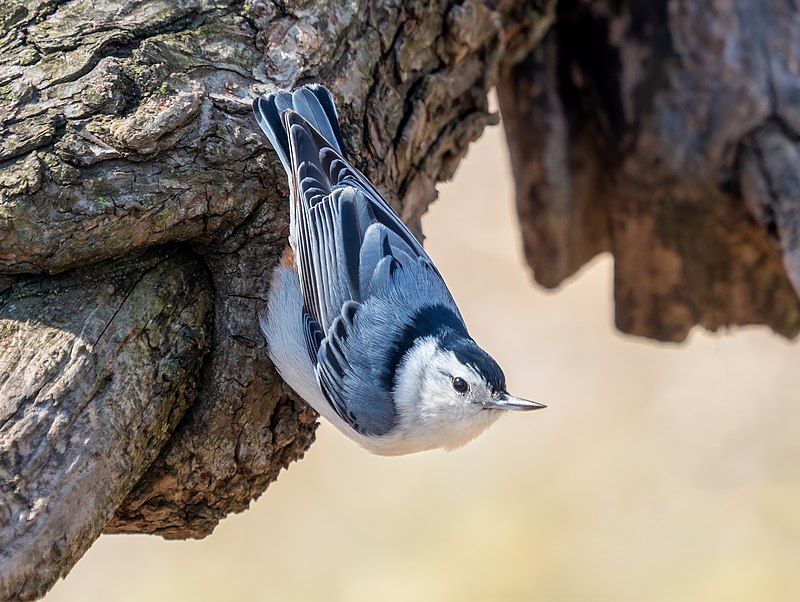
The White-Breasted Nuthatch, Sitta carolinensis, is a small and agile songbird found in North America. Its name comes from its distinctive habit of wedging nuts and seeds into tree bark crevices and then “hatching” them open with their sharp bills.
These birds are easily recognizable with their blue-gray upperparts, white face, and prominent white underparts. They are often seen climbing down tree trunks headfirst, a behavior not shared by many other birds.
White-Breasted Nuthatches primarily feed on insects, seeds, and nuts, and they prefer mature deciduous or mixed woodlands. Their cheerful calls and acrobatic antics make them a delightful addition to bird feeders and woodlands alike.
| Kingdom | Animalia |
| Phylum | Chordata |
| Clade | Dinosauria |
| Class | Aves |
| Order | Passeriformes |
| Family | Sittidae |
| Genus | Sitta |
| Species | S. carolinensis |
15. White-Throated Sparrow (Zonotrichia albicollis)
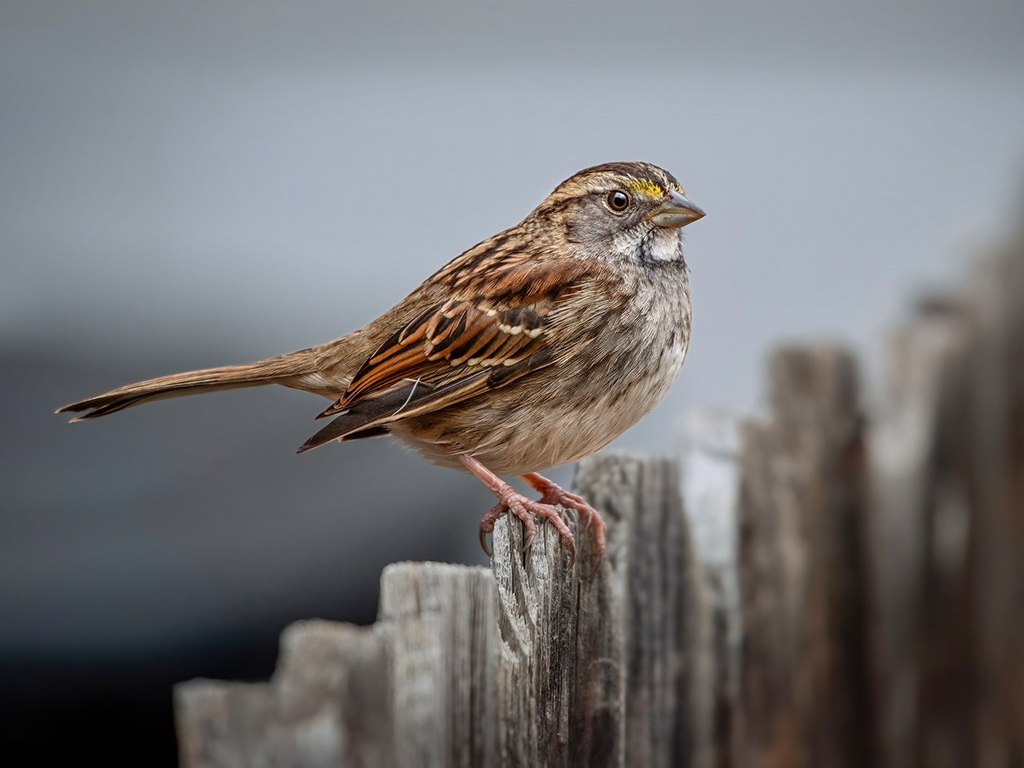
The White-Throated Sparrow is a medium-sized sparrow, measuring about 6.3-7.1 inches in length, known for its striking appearance and melodious song. It has a bold white throat patch, yellow lores (the area between the eye and beak), a gray face, and a black-and-white-striped crown. Its back is brown with streaks, and the underparts are grayish.
White-Throated Sparrows are often seen foraging on the ground in brushy or wooded areas, flicking through leaf litter to find seeds and insects. They are common in both urban and rural settings during the winter months. Their clear, whistled song, often transcribed as “Old Sam Peabody-Peabody-Peabody” or “Oh sweet Canada-Canada-Canada,” is a familiar sound in much of the eastern United States.
The White-Throated Sparrow is a medium-sized sparrow, measuring about 6.3-7.1 inches in length, known for its striking appearance and melodious song.
It has a bold white throat patch, yellow lores (the area between the eye and beak), a gray face, and a black-and-white-striped crown.
Its back is brown with streaks, and the underparts are grayish. White-Throated Sparrows are often seen foraging on the ground in brushy or wooded areas, flicking through leaf litter to find seeds and insects.
They are common in both urban and rural settings during the winter months. Their clear, whistled song, often transcribed as “Old Sam Peabody-Peabody-Peabody” or “Oh sweet Canada-Canada-Canada,” is a familiar sound in much of the eastern United States.
| Kingdom | Animalia |
| Phylum | Chordata |
| Clade | Dinosauria |
| Class | Aves |
| Order | Passeriformes |
| Family | Passerellidae |
| Genus | Zonotrichia |
| Species | Z. albicollis |
16. Tufted Titmouse (Baeolophus bicolor)
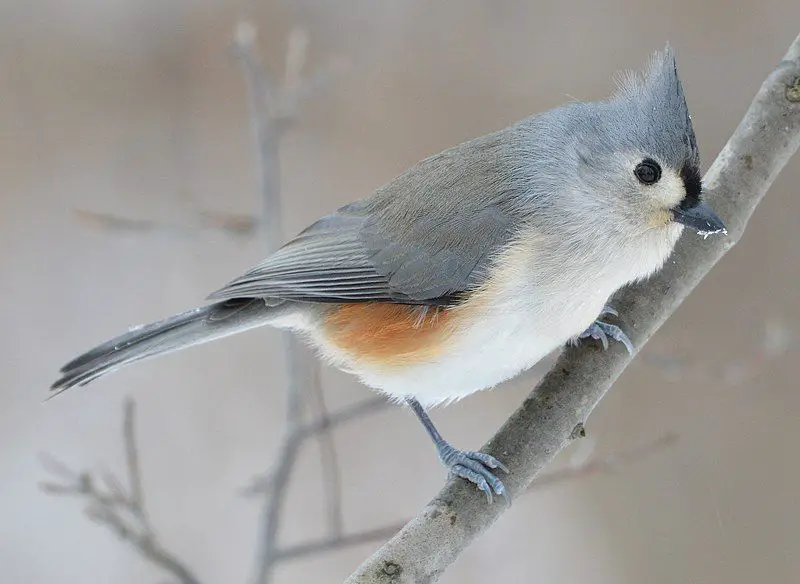
The Tufted Titmouse is a small songbird, about 5.5-6.3 inches in length, recognizable by its gray upperparts, white front, and a small crest on its head. They have a black patch above their beak and bright, curious eyes.
These birds are active and noisy, often seen flitting through trees in forests, gardens, and parks. They primarily feed on insects and seeds and are known to stash food for later consumption.
The Tufted Titmouse has a variety of calls, but its most common is a clear, whistled “peter-peter-peter.” They are social birds, often found in mixed flocks with chickadees, nuthatches, and other small birds.
| Kingdom | Animalia |
| Phylum | Chordata |
| Clade | Dinosauria |
| Class | Aves |
| Order | Passeriformes |
| Family | Paridae |
| Genus | Baeolophus |
| Species | B. bicolor |
17. Carolina Wren (Thryothorus ludovicianus)
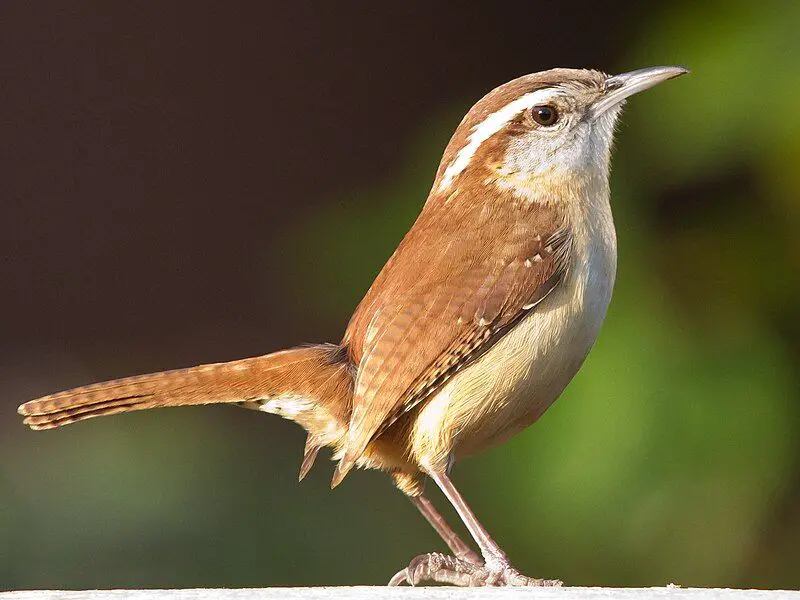
| Kingdom | Animalia |
| Phylum | Chordata |
| Clade | Dinosauria |
| Class | Aves |
| Order | Passeriformes |
| Family | Troglodytidae |
| Genus | Thryothorus |
| Species | T. ludovicianus |
18. American Crow (Corvus brachyrhynchos)
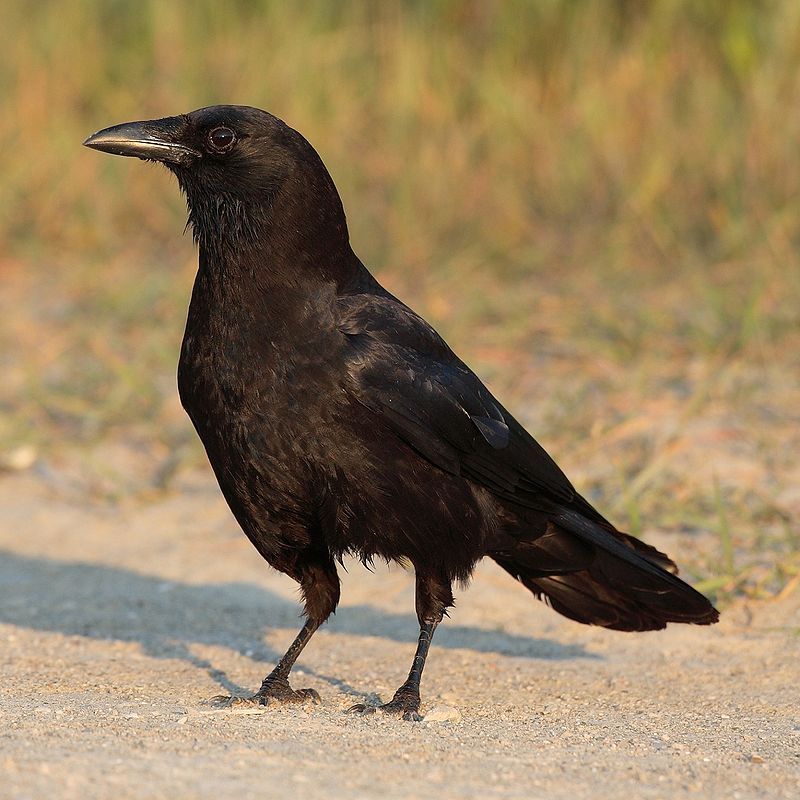
The American Crow is a large, intelligent, and adaptable bird, measuring about 16-21 inches in length. It has a completely black plumage, which can show a purplish sheen in bright sunlight.
The crow’s bill is strong and slightly curved, and its tail is fan-shaped. These birds are known for their complex social structures and advanced problem-solving abilities.
They have a diverse diet, feeding on insects, seeds, fruits, small animals, and carrion, and are not shy about scavenging in urban areas.
The American Crow’s call is a distinctive “caw-caw,” often heard in a series. They are very social, sometimes forming large flocks, especially in winter. Crows are also known for their habit of mobbing predators like hawks and owls.
| Kingdom | Animalia |
| Phylum | Chordata |
| Clade | Dinosauria |
| Class | Aves |
| Order | Passeriformes |
| Family | Corvidae |
| Genus | Corvus |
| Species | C. brachyrhynchos |
19. Northern Flicker (Colaptes auratus)
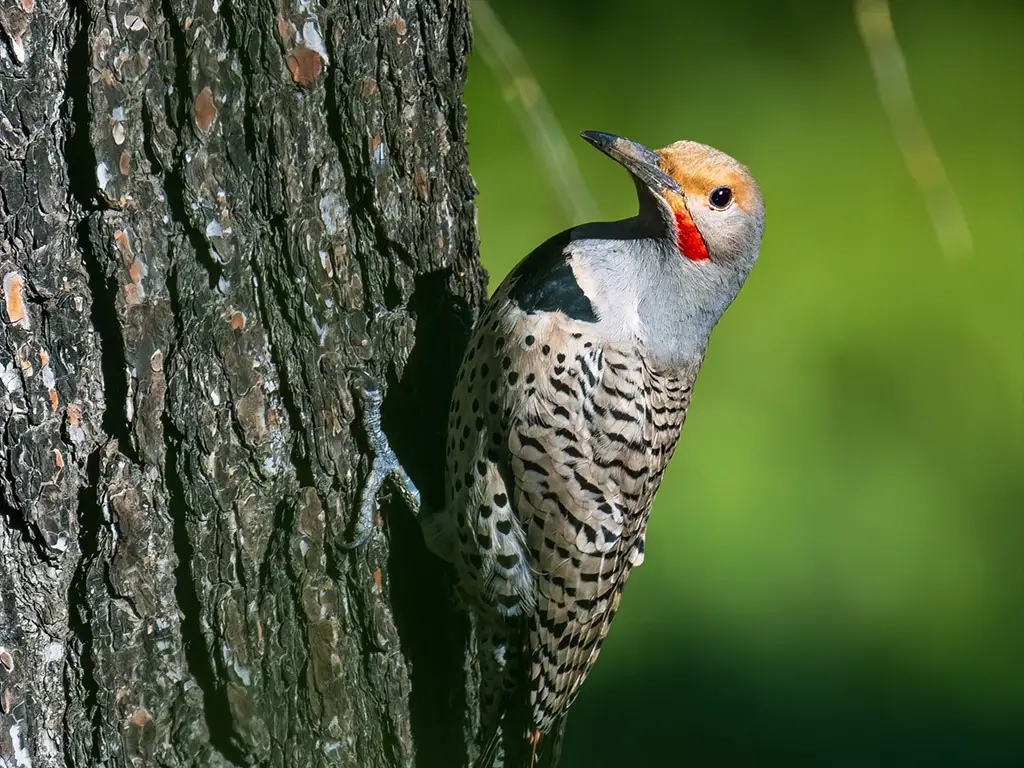
The Northern Flicker is a medium-sized woodpecker, about 11-14 inches in length. It’s unique among woodpeckers for its brownish body, black-spotted underparts, and a black bib.
The back is tan with black bars, and the tail is white with black bars. Males have a black or red mustache-like stripe on the face.
There are two main varieties: the yellow-shafted in the east and north, which has yellow under the wings and tail, and the red-shafted in the west, with red under the wings and tail.
Northern Flickers prefer to feed on the ground, mainly eating ants and beetles. Their call is a loud, rolling “wick wick wick wick.” They are often seen in open habitats near trees, including parks and yards.
| Kingdom | Animalia |
| Phylum | Chordata |
| Clade | Dinosauria |
| Class | Aves |
| Order | Piciformes |
| Family | Picidae |
| Genus | Colaptes |
| Species | C. auratus |
20. Eastern Bluebird (Sialia sialis)
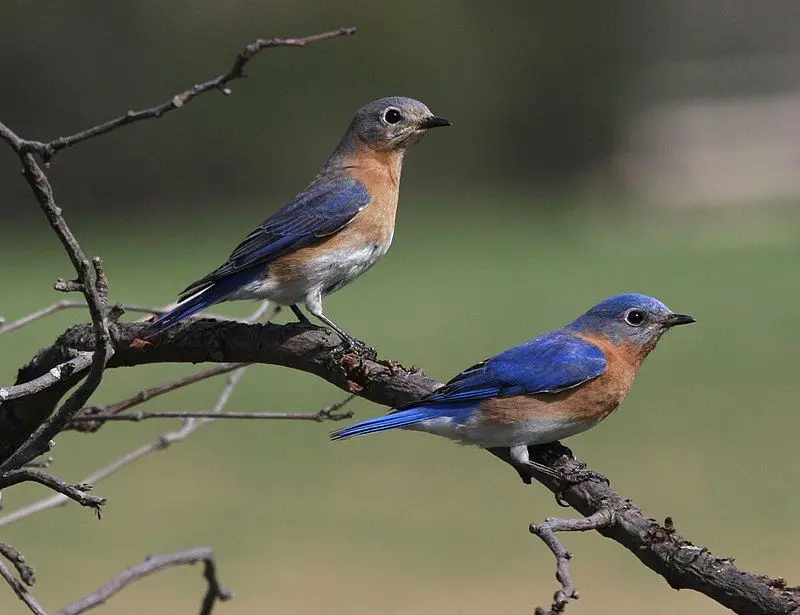
The Eastern Bluebird is a small thrush, measuring about 6.5-8.5 inches in length. Males have bright blue upperparts and a rusty red breast and throat, while females are more subdued with grayish-blue wings and tail and a lighter underpart.
They are known for their beautiful song and are often seen perching on wires and fences in open country with scattered trees. Eastern Bluebirds feed on insects and berries and are attracted to gardens with fruit-bearing plants and nest boxes.
They have become a conservation success story, with their numbers rebounding in recent years thanks to efforts to provide nest boxes in suitable habitats.
| Kingdom | Animalia |
| Phylum | Chordata |
| Clade | Dinosauria |
| Class | Aves |
| Order | Passeriformes |
| Family | Turdidae |
| Genus | Sialia |
| Species | S. sialis |
21. American Tree Sparrow (Spizelloides arborea)
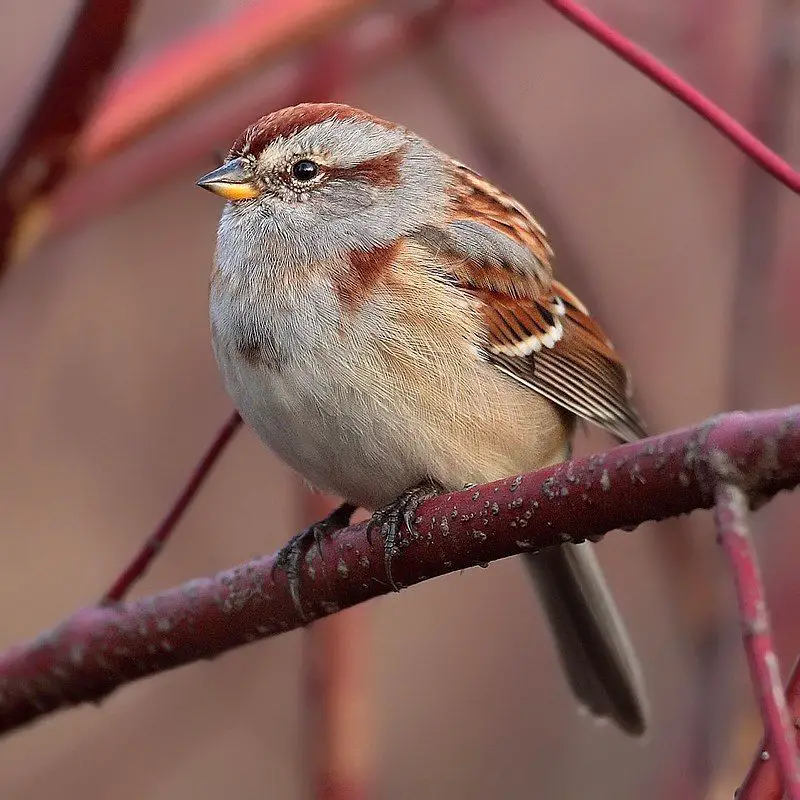
The American Tree Sparrow is a medium-sized sparrow, about 5.5-6.3 inches in length. In winter, it’s identified by its gray head with a rust-colored cap, black eye-line, and a small dark spot on its unstreaked gray breast.
The back is brown with streaks, and the wings show two white wing bars. They breed in the far northern tundra and winter in fields and open areas across much of the United States.
They feed on seeds and insects and are often seen in small flocks. Their song is a sweet, high-pitched whistle, and they have a distinctive “chip” call.
| Kingdom | Animalia |
| Phylum | Chordata |
| Clade | Dinosauria |
| Class | Aves |
| Order | Passeriformes |
| Family | Passerellidae |
| Genus | Spizelloides |
| Species | S. arborea |
22. Northern Cardinal (Cardinalis cardinalis)
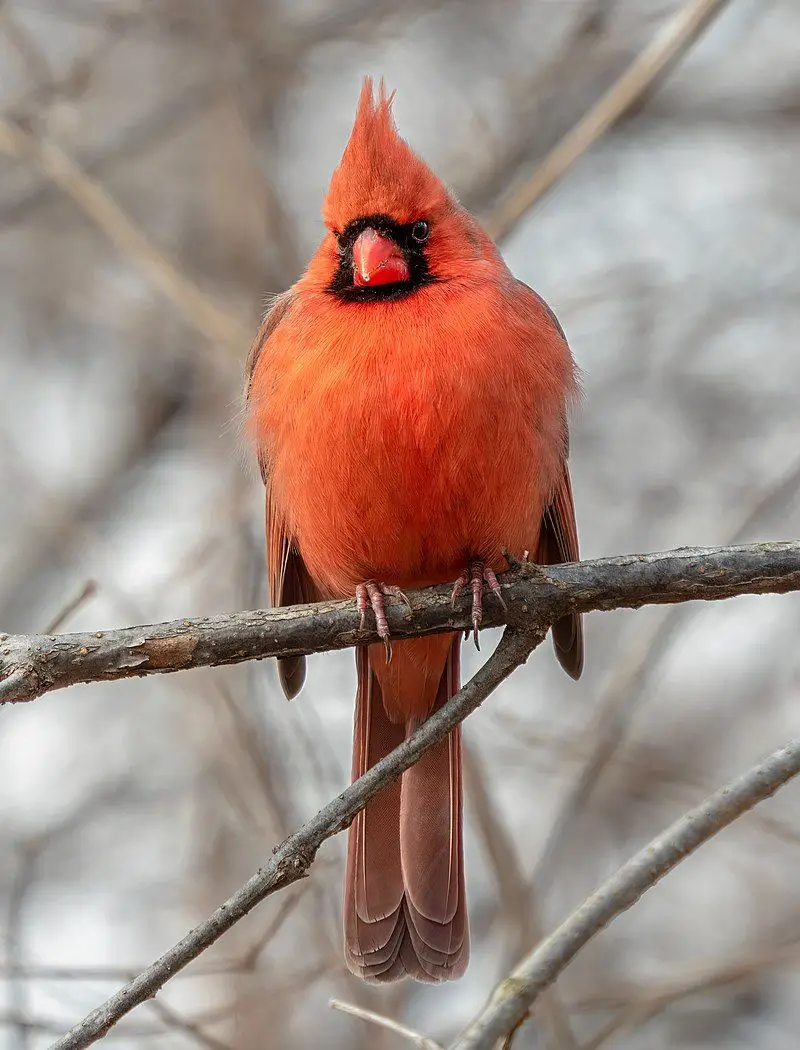
| Kingdom | Animalia |
| Phylum | Chordata |
| Clade | Dinosauria |
| Class | Aves |
| Order | Passeriformes |
| Family | Cardinalidae |
| Genus | Cardinalis |
| Species | C. cardinalis |
23. Cedar Waxwing (Bombycilla cedrorum)
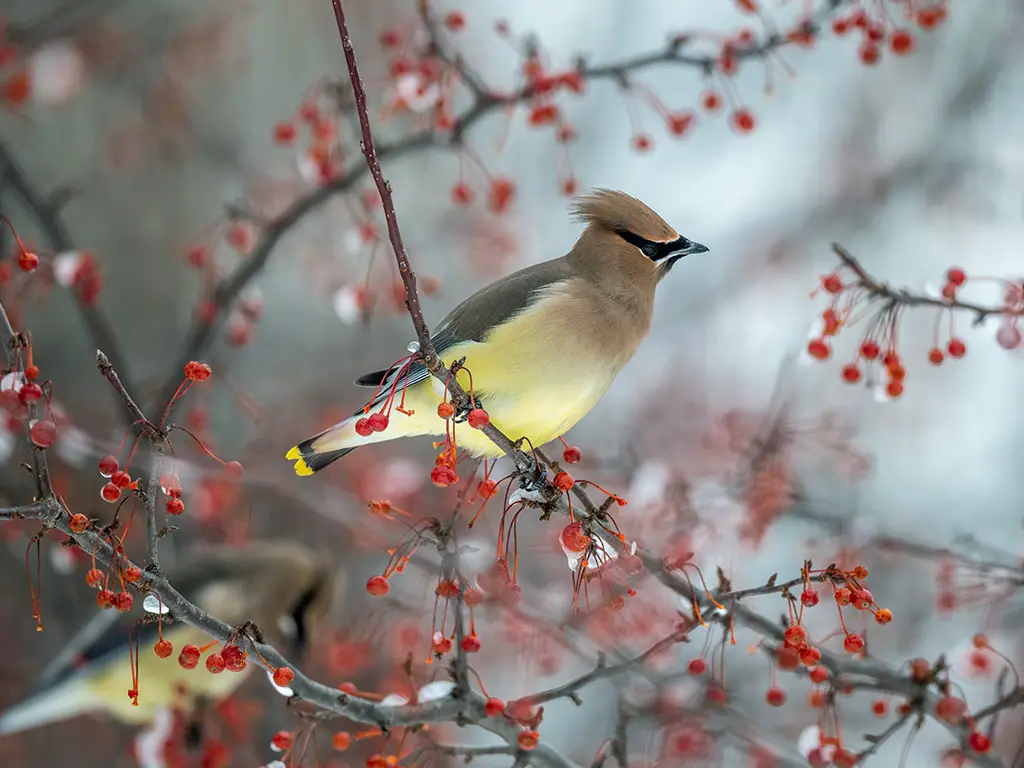
The Cedar Waxwing is a sleek, medium-sized bird, measuring about 5.5-7 inches in length. It is easily recognized by its smooth, silky plumage of soft gray, with a crest on its head, a black mask edged in white and a pale yellow belly.
The wings are distinctive, with red wax-like tips on the secondary feathers and bright yellow on the tail tip. Cedar Waxwings are sociable birds often seen in large flocks, especially around berry trees and shrubs.
They primarily feed on fruits and berries, but also consume insects, especially during breeding season. Their calls are high-pitched, thin whistles.
These birds are nomadic, wandering in search of fruiting plants, and are known for their gentle and tame behavior. Cedar Waxwings are also known for their unique courtship behavior, where they may pass a berry or flower petal back and forth.
| Kingdom | Animalia |
| Phylum | Chordata |
| Clade | Dinosauria |
| Class | Aves |
| Order | Passeriformes |
| Family | Bombycillidae |
| Genus | Bombycilla |
| Species | B. cedrorum |
24. Pine Siskin (Spinus pinus)
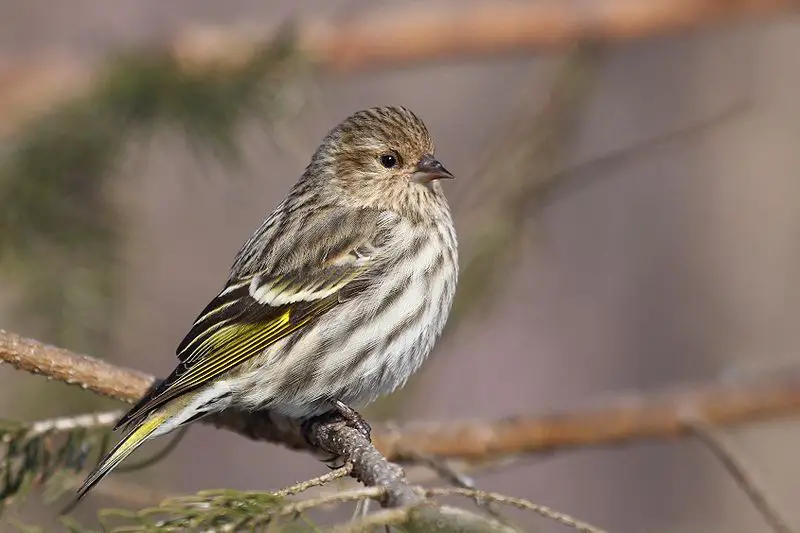
The Pine Siskin is a small, finch-like bird, measuring about 4-5 inches in length. It has a slender body with fairly pointed wings and a short, notched tail.
The bird’s plumage is brown with heavy streaking all over, and it usually shows a touch of yellow in the wings and tail, more visible during flight.
The bill is short and conical, typical of seed eaters. Pine Siskins are social birds, often seen in flocks, especially around feeders. They are known for their energetic behavior and twittering calls.
These birds primarily feed on seeds, especially those of conifers, as well as small insects. They are nomadic, with their movements unpredictable each year, often dependent on cone crop availability
| Kingdom | Animalia |
| Phylum | Chordata |
| Clade | Dinosauria |
| Class | Aves |
| Order | Passeriformes |
| Family | Fringillidae |
| Genus | Spinus |
| Species | S. pinus |
25. Bald Eagle (Haliaeetus leucocephalus)

The Bald Eagle, America’s national bird, is a large raptor known for its majestic appearance. It measures about 28-40 inches in length with a wingspan of 6-8 feet. Adults have a distinctive white head and tail contrasting with a dark brown body and wings.
The powerful bill, legs, and feet are bright yellow. Juveniles are brown with mottled white on the body and wings. Bald Eagles are primarily fish eaters, often seen soaring over water bodies or perched in tall trees.
They are also scavengers and can steal food from other birds. These birds are a symbol of strength and freedom, having made a remarkable comeback from near extinction in the mid-20th century. They are found near large bodies of open water with abundant fish and old-growth trees for nesting.
| Kingdom | Animalia |
| Phylum | Chordata |
| Clade | Dinosauria |
| Class | Aves |
| Order | Accipitriformes |
| Family | Accipitridae |
| Genus | Haliaeetus |
| Species | H. leucocephalus |
26. Red-Winged Blackbird (Agelaius phoeniceus)
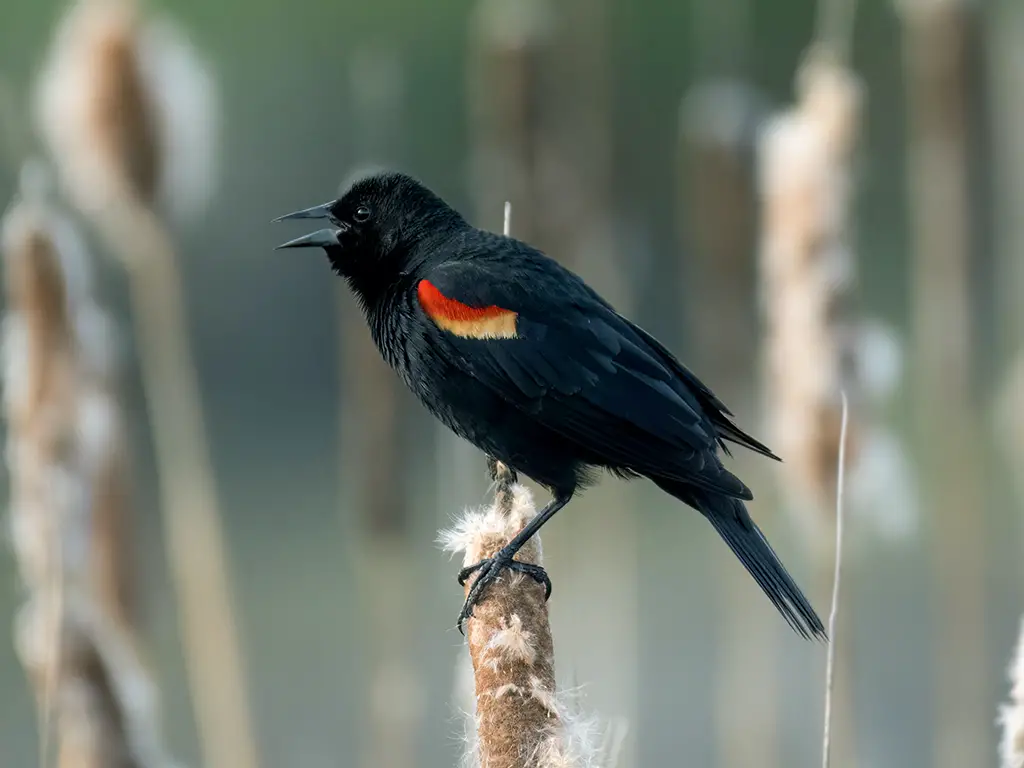
The Red-Winged Blackbird is a medium-sized bird, measuring about 7-9.5 inches in length. The male is unmistakable with its glossy black plumage and bright red shoulder patches edged with yellow.
Females are more subdued, with a streaky brown, sparrow-like appearance. These birds are known for their loud, conk-la-ree! song and are often seen perched on cattails or telephone wires.
They inhabit wetlands, marshes, and open fields, and their diet consists of insects, seeds, and grains. Red-winged blackbirds are highly social, often nesting in large colonies.
They are among the most abundant birds in North America, and their arrival is a sign of spring in many areas. Males are territorial during breeding season and can be seen aggressively defending their territory.
| Kingdom | Animalia |
| Phylum | Chordata |
| Clade | Dinosauria |
| Class | Aves |
| Order | Passeriformes |
| Family | Icteridae |
| Genus | Agelaius |
| Species | A. phoeniceus |
27. Red-Tailed Hawk (Buteo jamaicensis)
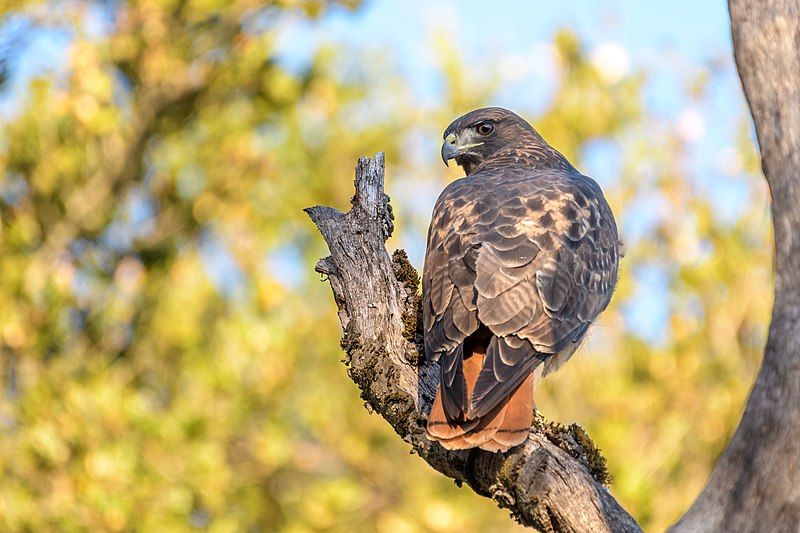
The Red-Tailed Hawk is a large bird of prey, measuring about 18-26 inches in length with a wingspan of 4 to 5 feet. It’s known for its distinctive reddish-brown tail, which is most vivid in adults.
The bird’s upper parts are usually brown, while the underparts are pale with a band of dark streaks. Red-tailed hawks are versatile hunters and can be seen soaring in wide circles high above fields, forests, and highways.
They primarily feed on small mammals, birds, and reptiles. These hawks are adaptable to various environments, including deserts, grasslands, forests, agricultural fields, and even urban areas.
They have a piercing call, often heard in movies as the generic sound of any raptor. Their powerful vision allows them to spot prey from great heights.
| Kingdom | Animalia |
| Phylum | Chordata |
| Clade | Dinosauria |
| Class | Aves |
| Order | Accipitriformes |
| Family | Accipitridae |
| Genus | Buteo |
| Species | B. jamaicensis |
28. Red-Breasted Nuthatch (Sitta canadensis)
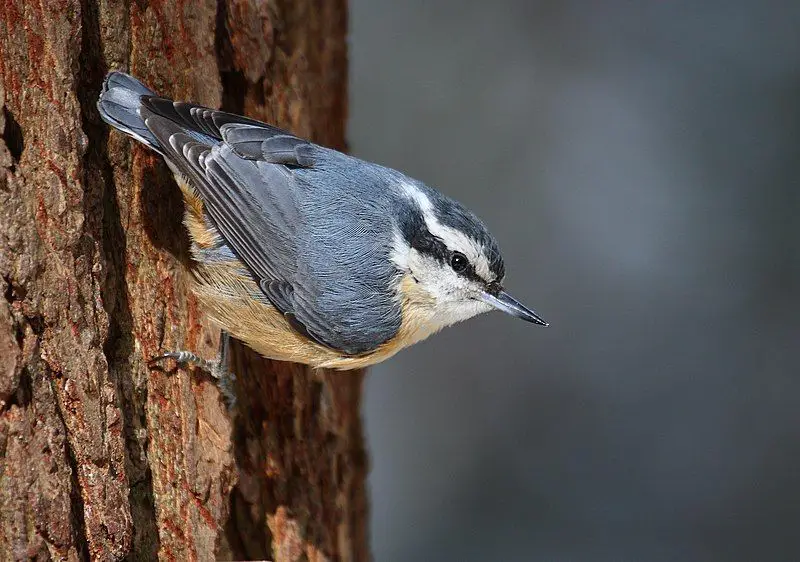
The Red-Breasted Nuthatch is a small bird, measuring about 4.5 inches in length. It has a distinctive appearance with a black stripe on its head, a rusty-red underbelly, and blue-gray upperparts.
These birds are known for their ability to climb down trees headfirst, unlike most other birds. They have a sharp, pointed bill, which they use to excavate insects from bark, and they also eat seeds and nuts.
The Red-Breasted Nuthatch has a distinctive nasal call, often described as a tinny “yank-yank.” They are common in coniferous and mixed forests and are known for caching food for later consumption. In winter, they can sometimes be found in mixed flocks with chickadees and titmice.
| Kingdom | Animalia |
| Phylum | Chordata |
| Clade | Dinosauria |
| Class | Aves |
| Order | Passeriformes |
| Family | Sittidae |
| Genus | Sitta |
| Species | S. canadensis |
29. Mallard (Anas platyrhynchos)
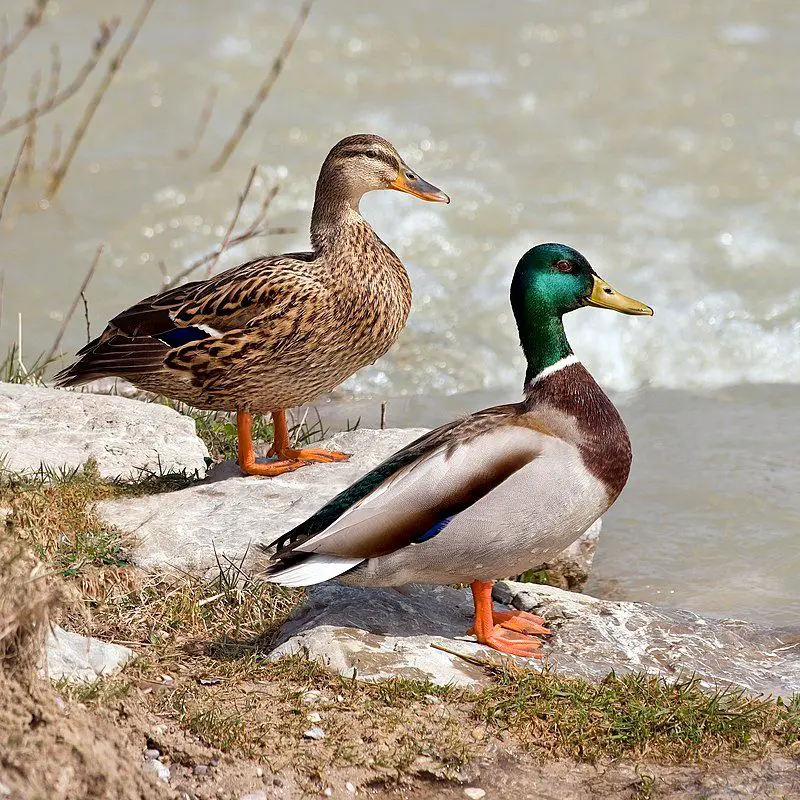
The Mallard is a familiar and widespread duck, measuring about 20-26 inches in length. The male Mallard is particularly striking during breeding season with its glossy green head, white neck ring, chestnut-brown chest, and gray body.
Females are mottled brown with an orange bill marked with black. Mallards are dabbling ducks, feeding at the water’s surface, and are commonly found in a variety of wetland habitats, including ponds, rivers, and marshes.
They have a varied diet, including aquatic plants, insects, and small fish. Mallards are also the ancestors of most domestic ducks and are known for their distinctive quacking sound, particularly by females.
| Kingdom | Animalia |
| Phylum | Chordata |
| Clade | Dinosauria |
| Class | Aves |
| Order | Anseriformes |
| Family | Anatidae |
| Genus | Anas |
| Species | A. platyrhynchos |
30. American Black Duck (Anas rubripes)
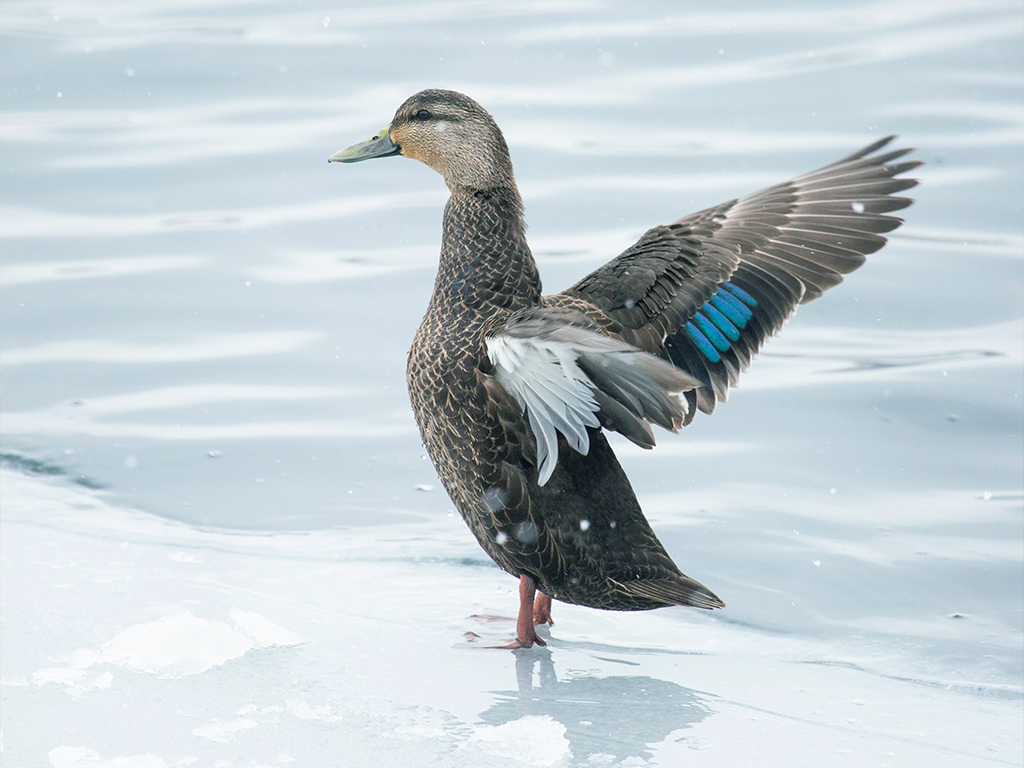
The American Black Duck is a large, dabbling duck, similar in size and shape to the Mallard. Despite its name, its plumage is dark brown rather than black, with lighter underwings visible in flight.
The bird’s bill is yellowish-green. American Black Ducks are often found in marshes, rivers, and coastal habitats, where they feed on plant material, insects, and small fish.
They are known for being more wary and elusive than Mallards. Their numbers have declined due to habitat loss and competition with Mallards, but they remain a common sight in Eastern North America.
These ducks are important to waterfowl hunters and are often seen in mixed flocks with Mallards.
| Kingdom | Animalia |
| Phylum | Chordata |
| Clade | Dinosauria |
| Class | Aves |
| Order | Anseriformes |
| Family | Anatidae |
| Genus | Anas |
| Species | A. rubripes |
31. European Herring Gull (Larus argentatus)
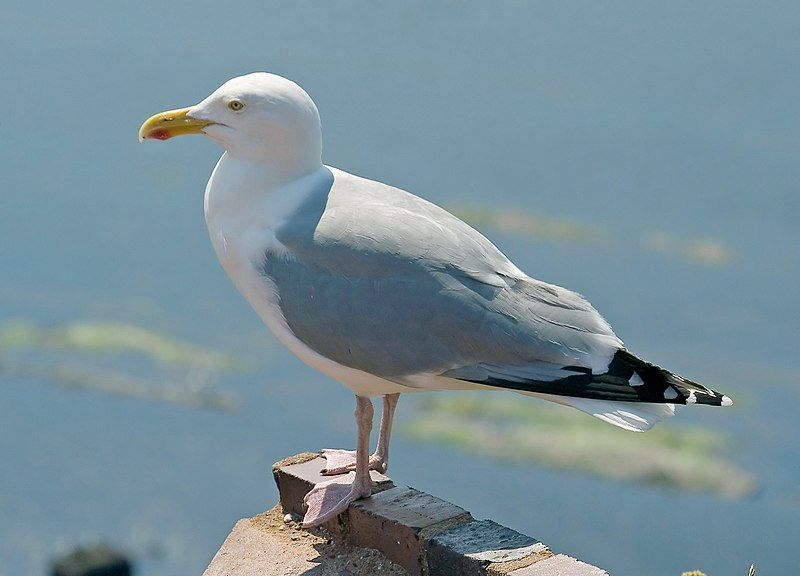
| Kingdom | Animalia |
| Phylum | Chordata |
| Clade | Dinosauria |
| Class | Aves |
| Order | Charadriiformes |
| Family | Laridae |
| Genus | Larus |
| Species | L. argentatus |
32. Ring-Billed Gull (Larus delawarensis)
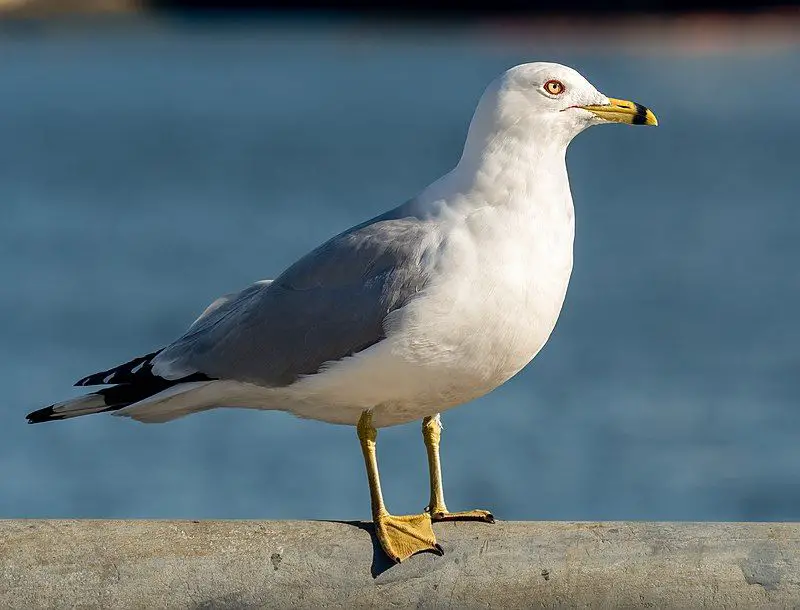
The Ring-Billed Gull is a medium-sized gull, measuring about 17-21 inches in length with a wingspan of 41-46 inches. Adults have a white head, neck, underparts, and tail, with a light gray back and upper wings.
The bill is yellow with a distinctive black ring near the tip, giving the species its name. The legs are yellow, and the eyes are yellow with a red orbital ring. Juveniles are mottled brown and take several years to acquire the adult plumage.
Ring-billed gulls are commonly found in a variety of habitats including lakes, rivers, beaches, fields, and parking lots, often near humans.
They have a varied diet consisting of fish, insects, grains, and food waste. These gulls are known for their loud, laughing call and are a familiar sight in many parts of North America, especially during migration.
| Kingdom | Animalia |
| Phylum | Chordata |
| Clade | Dinosauria |
| Class | Aves |
| Order | Charadriiformes |
| Family | Laridae |
| Genus | Larus |
| Species | L. delawarensis |
33. Red-Headed Woodpecker (Melanerpes erythrocephalus)
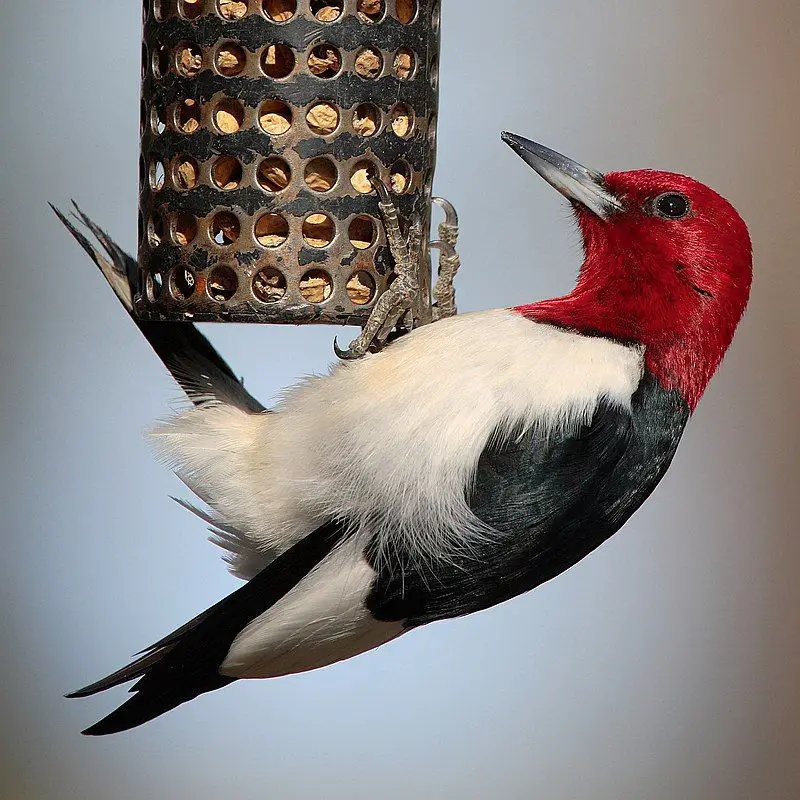
The Red-Headed Woodpecker is a striking bird, about 7-9 inches long. It’s easily recognized by its bright red head, neck, and throat, contrasting with its black back, wings, tail, and white belly.
Juveniles have brown heads with white and black on the body. This woodpecker is found in open woodlands, parks, and orchards. It feeds on insects, fruits, nuts, and seeds, and is known for catching insects in flight, a behavior not common among other woodpeckers.
The Red-Headed Woodpecker also stores food in tree crevices for later use. They have a distinctive, loud call and are also known for their drumming on trees. Populations have declined in some areas due to habitat loss and competition for nesting sites.
| Kingdom | Animalia |
| Phylum | Chordata |
| Clade | Dinosauria |
| Class | Aves |
| Order | Piciformes |
| Family | Picidae |
| Genus | Melanerpes |
| Species | M. erythrocephalus |
34. Ruby-Throated Hummingbird (Archilochus colubris)
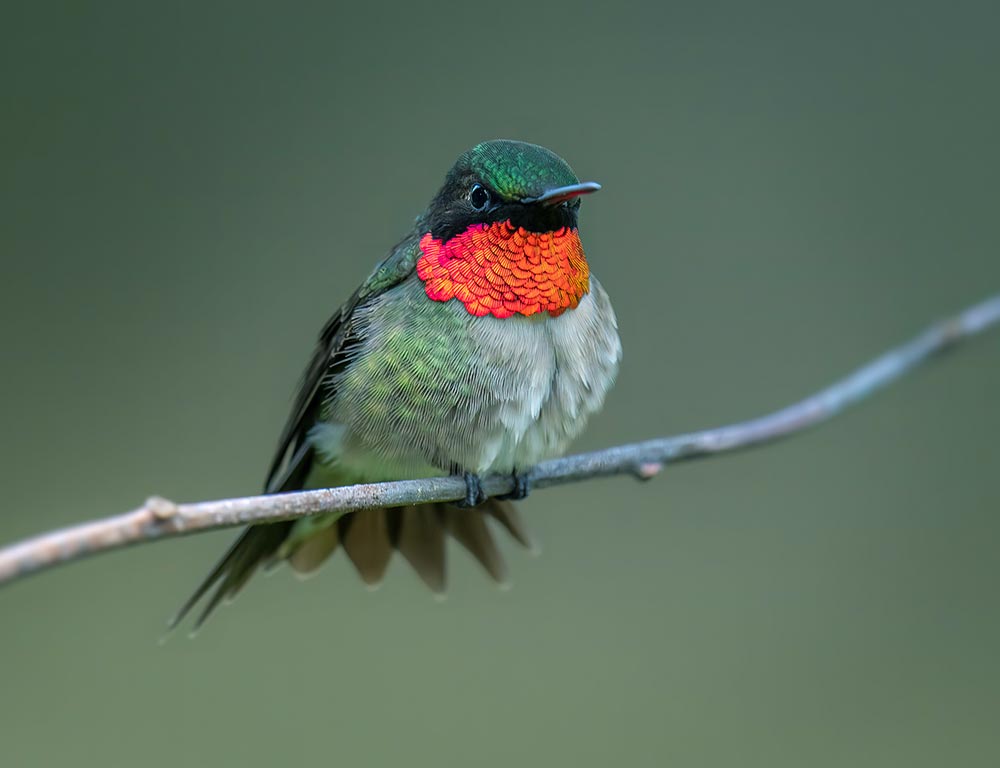
The Ruby-Throated Hummingbird is a small, vibrant bird, measuring about 3-3.5 inches in length. Males have a brilliant iridescent ruby-red throat and a white collar, emerald green upper parts, and a forked tail.
Females lack the red throat and have a notched, white-tipped tail. They are known for their incredible flying skills, including hovering and flying backward.
Ruby-throated hummingbirds feed primarily on nectar from flowers, using their long, extendable tongues, but also eat small insects and spiders.
They are migratory, spending winters in Central America and summers throughout eastern North America. These birds are attracted to red and orange flowers and are commonly seen in gardens with hummingbird feeders.
| Kingdom | Animalia |
| Phylum | Chordata |
| Clade | Strisores |
| Class | Aves |
| Order | Apodiformes |
| Family | Trochilidae |
| Genus | Archilochus |
| Species | A. colubris |
35. Eastern Screech Owl (Megascops asio)
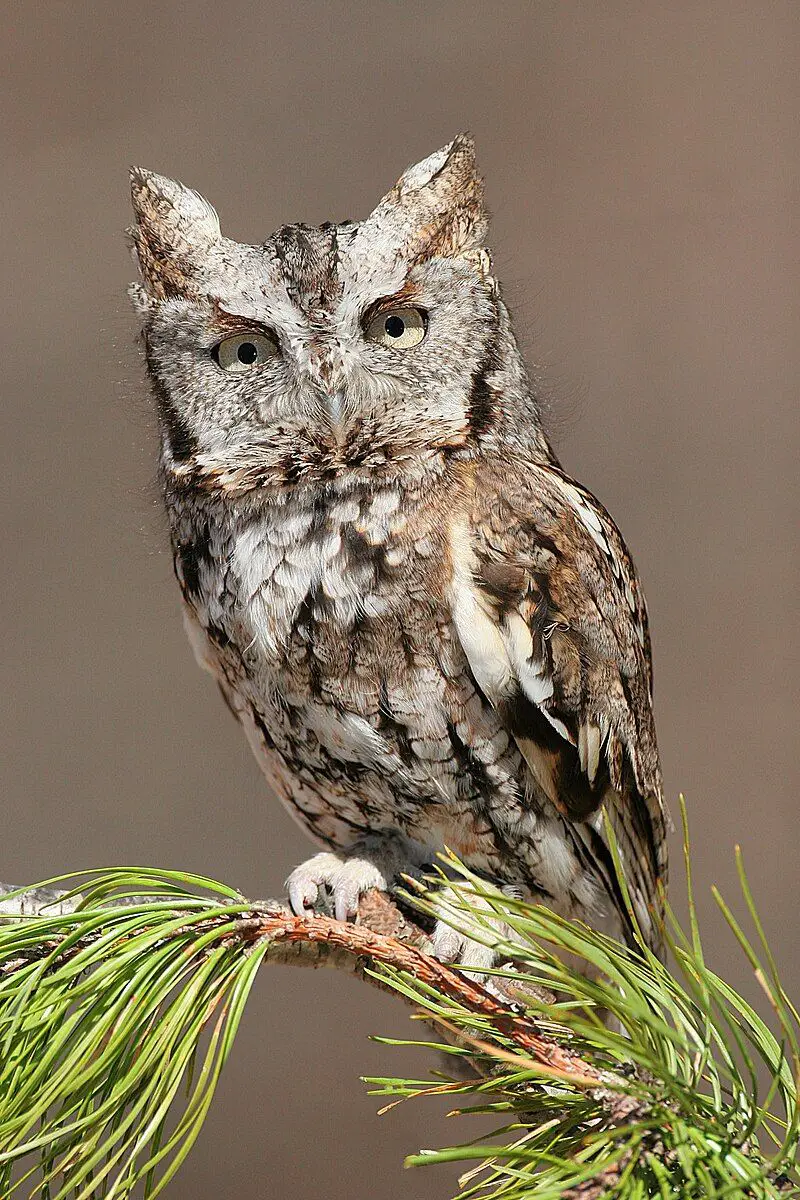
| Kingdom | Animalia |
| Phylum | Chordata |
| Clade | Dinosauria |
| Class | Aves |
| Order | Strigiformes |
| Family | Strigidae |
| Genus | Megascops |
| Species | M. asio |
36. Purple Finch (Haemorhous purpureus)
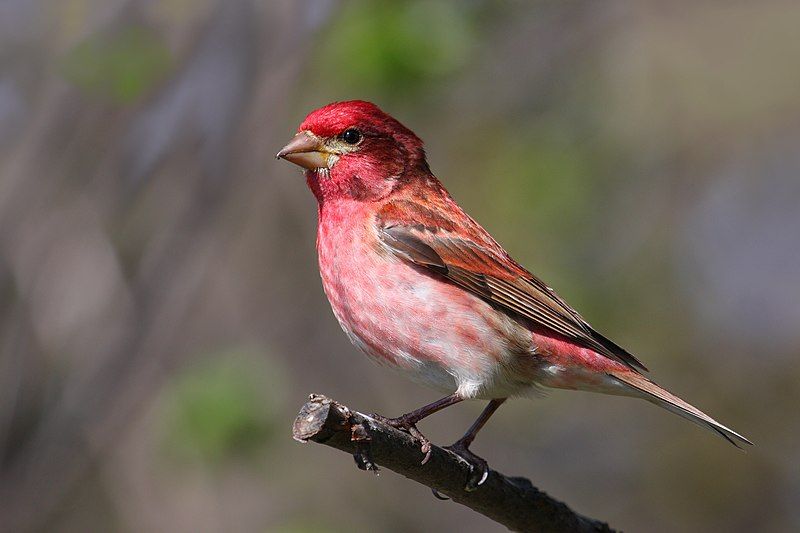
The Purple Finch is a small bird, measuring about 4.7-6 inches in length. The male is notable for its vibrant raspberry redhead, throat, breast, and rump, which contrasts with its brown back and wings.
This coloring can vary in intensity. Females and young males are more subdued, with a brown-streaked white underbelly and a streaked brown back. Purple Finches can be found in coniferous and mixed forests, as well as in suburban areas and backyard feeders.
They primarily feed on seeds, berries, and insects. Their song is a rich warble, reminiscent of a warbling vireo but more musical.
These finches are known for their bold behavior at feeders and are often seen in flocks, especially during migration. The Purple Finch is the state bird of New Hampshire and is appreciated for its cheerful song and colorful appearance.
| Kingdom | Animalia |
| Phylum | Chordata |
| Clade | Dinosauria |
| Class | Aves |
| Order | Passeriformes |
| Family | Fringillidae |
| Genus | Haemorhous |
| Species | H. purpureus |
37. Ruby-Crowned Kinglet (Regulus calendula)
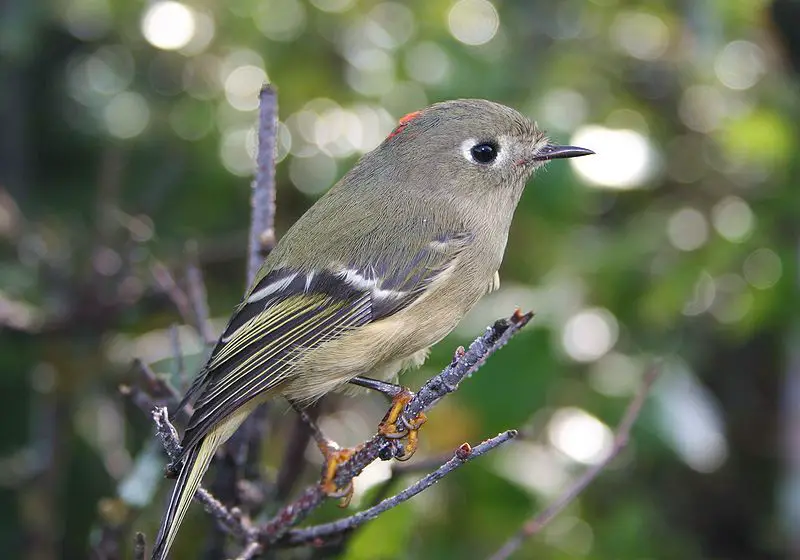
The Ruby-Crowned Kinglet is a tiny, energetic bird, measuring about 3.5-4 inches in length. Its plumage is predominantly olive-green, with a white eye ring and two white wing bars.
The male has a hidden surprise—a vibrant ruby-red crown patch that is usually concealed but can be raised as a display during territorial disputes or courtship.
These kinglets are found in coniferous and mixed forests across North America, as well as during migration in a variety of habitats.
They feed primarily on insects and spiders and are known for their constant and restless foraging behavior. The Ruby-Crowned Kinglet’s high-pitched, musical song consists of a rapid series of notes, while its call is a sharp “tseet.”
These birds are agile flyers and are often seen hovering as they glean insects from leaves and branches.
| Kingdom | Animalia |
| Phylum | Chordata |
| Clade | Dinosauria |
| Class | Aves |
| Order | Passeriformes |
| Family | Regulidae |
| Genus | Corthylio |
| Species | C. calendula |
38. Brown Creeper (Certhia americana)
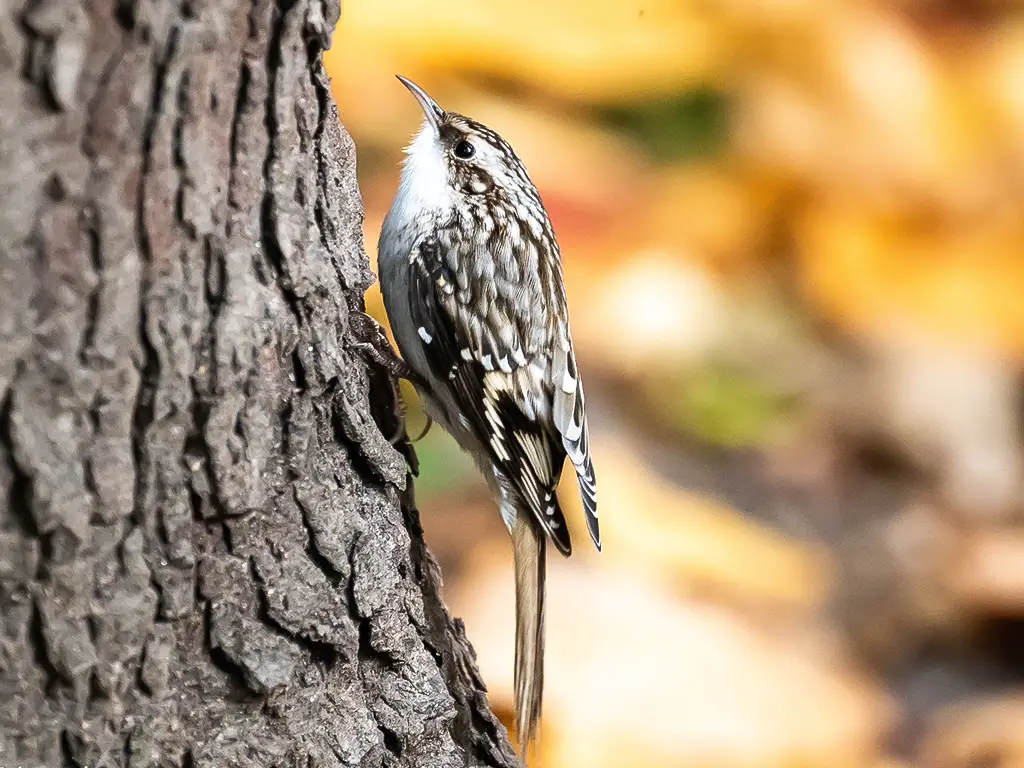
The Brown Creeper is a small, cryptic bird, measuring about 4.5-5 inches in length. It has mottled brown plumage that provides excellent camouflage against tree bark, helping it blend in while it searches for insects and spiders.
These birds are often seen spiraling up tree trunks in a distinctive manner, using their long, curved bills to probe for insects hidden in bark crevices.
Brown Creepers have a soft, high-pitched, trilling song that is often heard during the breeding season. They are typically found in mature forests and woodlands across North America and are known for their elusive nature and quiet presence.
Despite their small size, their unique foraging behavior and appearance make them an interesting and sought-after bird for birdwatchers.
| Kingdom | Animalia |
| Phylum | Chordata |
| Clade | Dinosauria |
| Class | Aves |
| Order | Passeriformes |
| Family | Certhiidae |
| Genus | Certhia |
| Species | C. americana |
39. Long-Eared Owl (Asio otus)
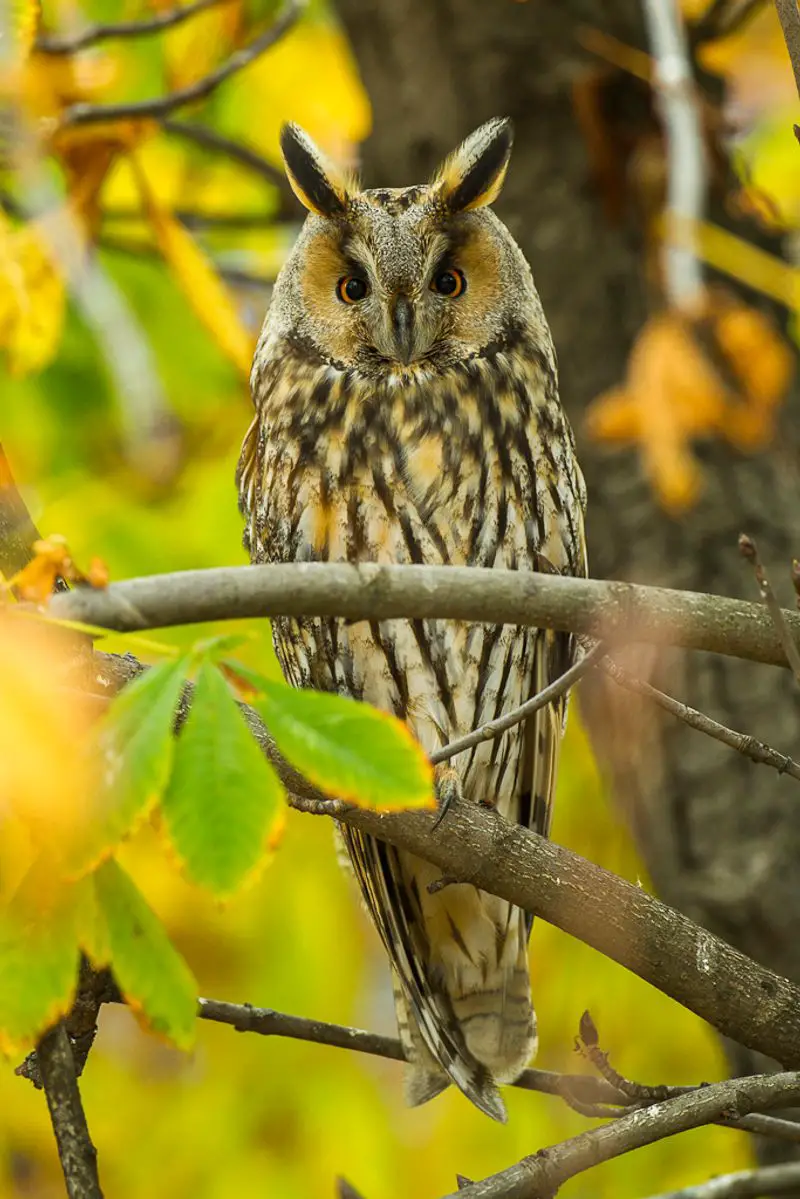
The Long-Eared Owl is a medium-sized owl, measuring about 13-16 inches in length with a wingspan of 35-42 inches. It has striking orange eyes set in a facial disc of brown and tan feathers.
The name “Long-Eared” refers to the tufts of feathers (ear tufts) on its head, although these tufts are often not visible. The rest of the plumage is streaked brown and buff. Long-eared owls are nocturnal and are known for their secretive and elusive behavior.
They inhabit woodlands and open areas, where they hunt for small mammals such as voles and mice. They have a soft, muffled hooting call and are generally quiet during the day when they roost in dense vegetation or tree branches.
These owls are skilled hunters and are sometimes seen perched in open areas at dusk and dawn.
| Kingdom | Animalia |
| Phylum | Chordata |
| Clade | Dinosauria |
| Class | Aves |
| Order | Strigiformes |
| Family | Strigidae |
| Genus | Asio |
| Species | A. otus |
40. Osprey (Pandion haliaetus)
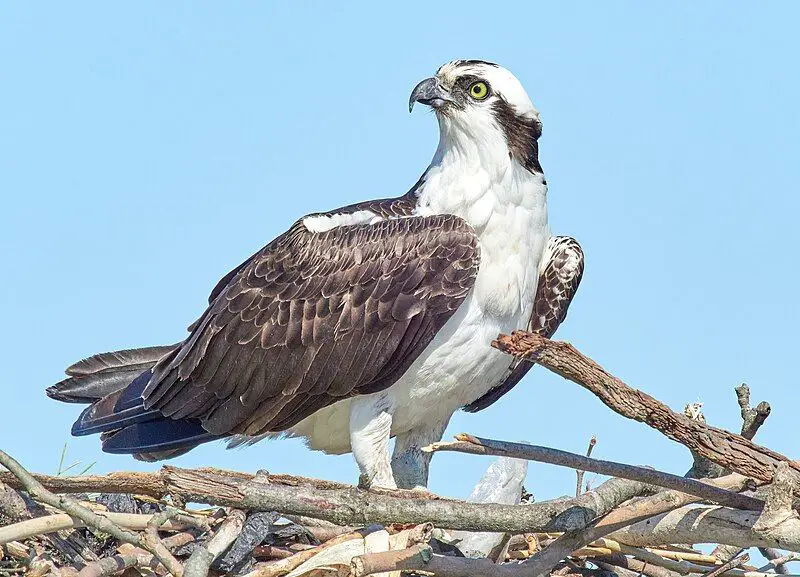
The Osprey, also known as the “fish hawk,” is a large raptor with a wingspan of 59-67 inches and a length of 20-24 inches. It has a distinctive appearance, with mostly white underparts, brown-streaked upperparts, and a black eye mask.
Ospreys are specialized fish hunters and are often seen flying over bodies of water, where they dive feet-first to catch fish with their sharp talons. Their feet are equipped with unique spiny scales to help grip slippery fish.
Ospreys have a high-pitched, whistling call that is often heard near their nesting sites. They build large stick nests on platforms or structures near water bodies.
Ospreys are migratory birds, spending summers in North America and winters in Central and South America. Their recovery from near-extinction due to pesticides like DDT is a conservation success story.
| Kingdom | Animalia |
| Phylum | Chordata |
| Clade | Dinosauria |
| Class | Aves |
| Order | Accipitriformes |
| Family | Pandionidae |
| Genus | Pandion |
| Species | P. haliaetus |
41. Brambling (Fringilla montifringilla)
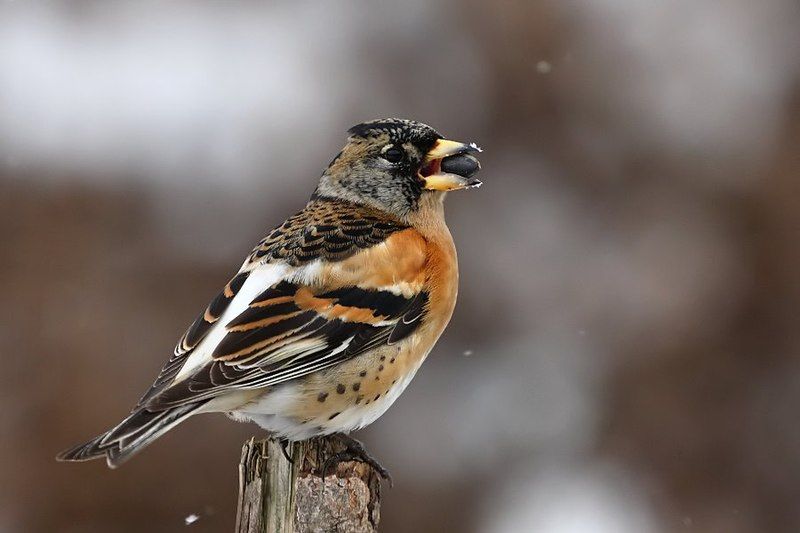
The Brambling is a small, migratory finch, measuring about 5.5-7 inches in length. It has a colorful plumage, with orange and black markings on the head, a white belly, and dark wings with white wing bars.
Bramblings are found in coniferous and mixed forests of northern Eurasia during the breeding season. They have a varied diet, including seeds, fruits, and insects.
These finches are known for their irregular winter migrations, which can bring them to parts of North America, although they are considered rare in the United States. Bramblings are gregarious birds and are often seen in flocks during the non-breeding season.
Their melodious song and social behavior make them a delight to observe when they visit North American bird feeders.
| Kingdom | Animalia |
| Phylum | Chordata |
| Clade | Dinosauria |
| Class | Aves |
| Order | Passeriformes |
| Family | Fringillidae |
| Genus | Fringilla |
| Species | F. montifringilla |
42.Sandhill Crane (Antigone canadensis)
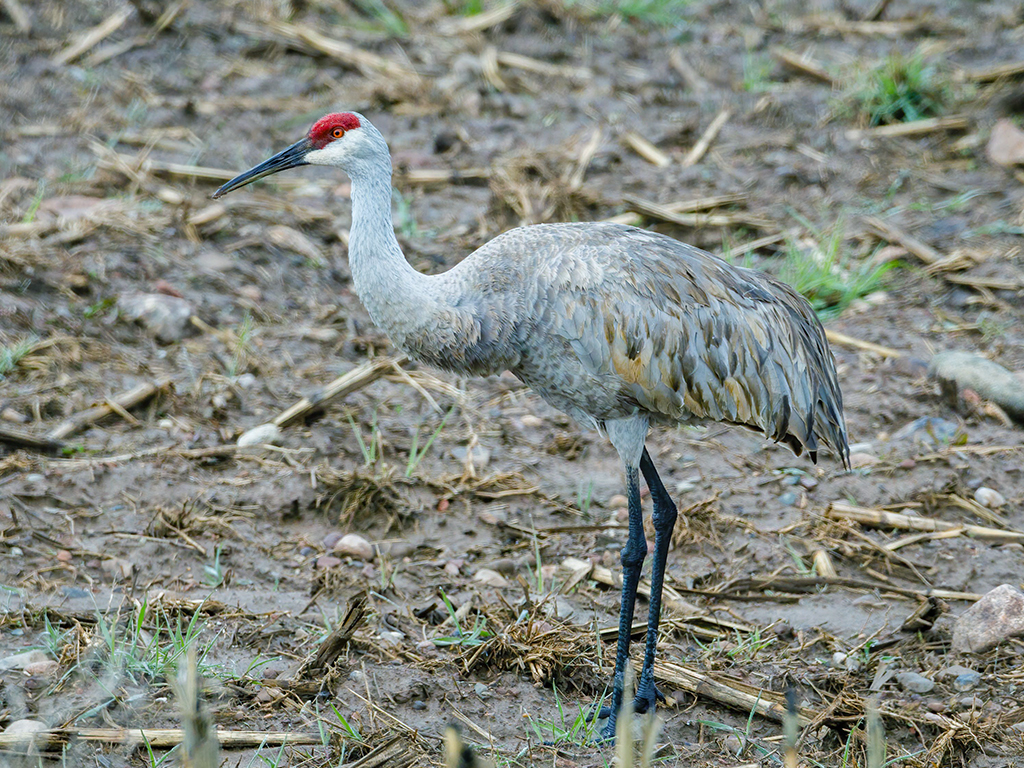
The Sandhill Crane is a large, striking bird, measuring about 31-40 inches in length with a wingspan of 5.5-7 feet. It has a grayish plumage with a red crown and a bare, red forehead.
These cranes are known for their loud, trumpeting calls, especially during their courtship dances. Sandhill Cranes are often seen in wetlands, marshes, and open grasslands, where they feed on plants, seeds, and small animals.
They have a unique courtship dance that involves synchronized jumping, calling, and elaborate displays. Sandhill Cranes are highly migratory, with some populations traveling long distances between breeding and wintering grounds.
They are a conservation success story, as their populations have rebounded after years of decline due to hunting and habitat loss. These elegant cranes are a symbol of wetland conservation efforts.
| Kingdom | Animalia |
| Phylum | Chordata |
| Clade | Dinosauria |
| Class | Aves |
| Order | Gruiformes |
| Family | Gruidae |
| Genus | Antigone |
| Species | A. canadensis |
43. Pied-Billed Grebe (Podilymbus podiceps)
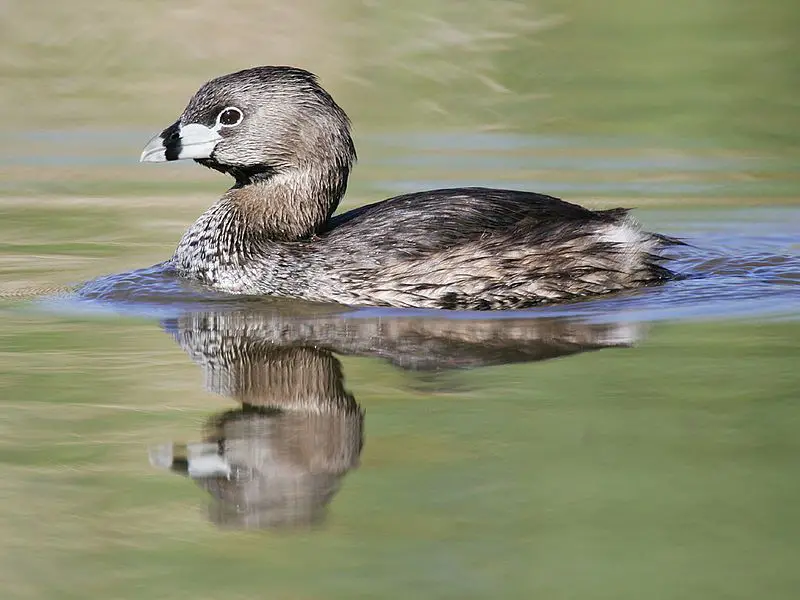
The Pied-billed Grebe is a small, diving waterbird, measuring about 9-15 inches in length with a wingspan of 16-24 inches. It gets its name from the distinctive black stripe (or “bill”) across its otherwise pale, stubby beak.
This grebe is known for its ability to sink low in the water, leaving only its head and neck visible, making it appear snake-like. They are excellent swimmers and divers, primarily feeding on small fish, insects, and aquatic vegetation.
Pied-billed grebes are often found in freshwater lakes, ponds, and marshes. Their calls are a series of “kow-kow” or “oop-oop” sounds.
During the breeding season, they build floating nests on the water’s surface. These birds are known for their secretive behavior, often disappearing underwater when approached.
| Kingdom | Animalia |
| Phylum | Chordata |
| Clade | Dinosauria |
| Class | Aves |
| Order | Podicipediformes |
| Family | Podicipedidae |
| Genus | Podilymbus |
| Species | P. podiceps |
44. American White Pelican (Pelecanus erythrorrhynchos)

The American White Pelican is a large, striking waterbird, with a wingspan of 9-10 feet and a length of about 50-67 inches. It has white plumage with black wingtips, and during the breeding season, it develops a prominent knob on its bill.
These pelicans are known for their impressive soaring flights in V-shaped formations. Unlike their brown pelican relatives, they do not dive for fish but instead forage by swimming on the water’s surface, scooping up fish with their large bills.
American White Pelicans are commonly found in freshwater lakes, rivers, and coastal areas. Their calls are often described as low grunts and growls.
These pelicans are migratory, spending winters in warmer regions of North America. They are sociable birds and often gather in large flocks during migration.
| Kingdom | Animalia |
| Phylum | Chordata |
| Clade | Dinosauria |
| Class | Aves |
| Order | Pelecaniformes |
| Family | Pelecanidae |
| Genus | Pelecanus |
| Species | P. erythrorhynchos |
45. Great Cormorant (Phalacrocorax carbo)
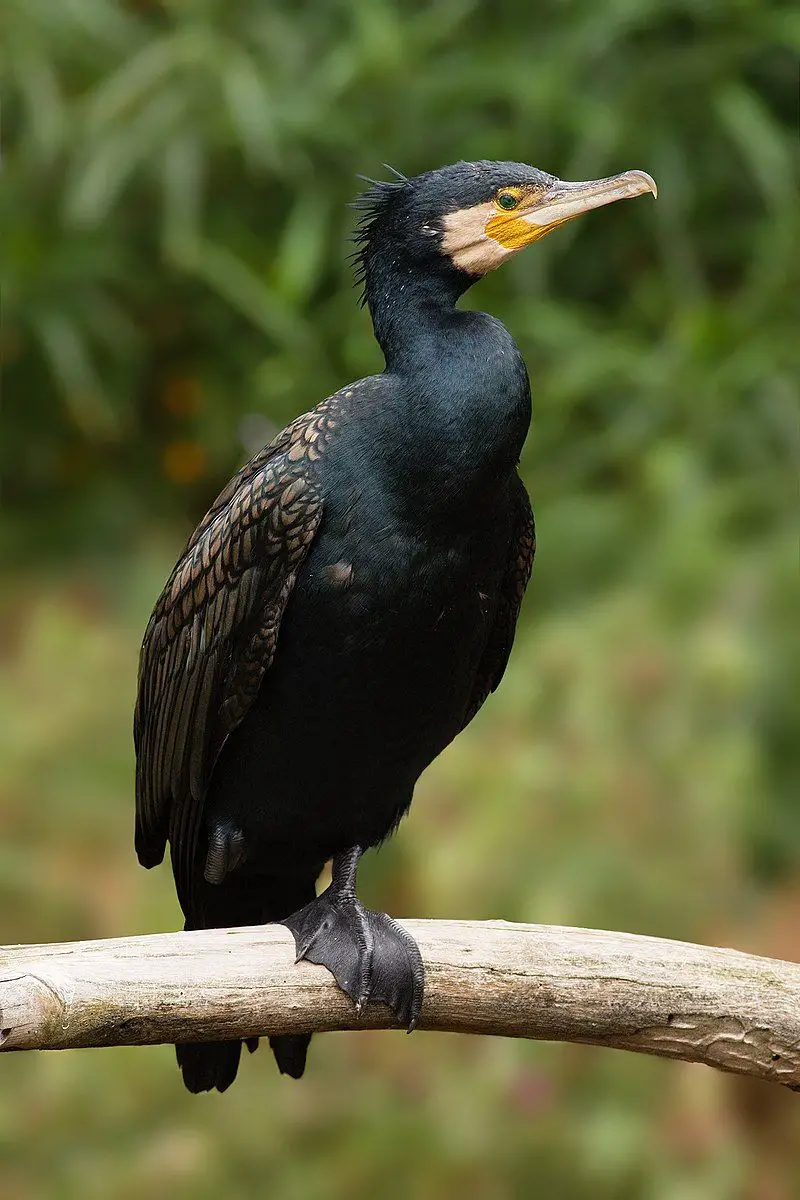
The Great Cormorant is a large waterbird, measuring about 28-35 inches in length with a wingspan of 48-59 inches. It has black plumage with a glossy green sheen, a long neck, and a distinctive hooked bill.
These cormorants are excellent swimmers and divers, using their webbed feet to propel themselves underwater to catch fish. They are often seen perched with their wings spread wide to dry, as their feathers are not as waterproof as those of other waterbirds.
Great Cormorants are found in a variety of aquatic habitats, including coastal areas, lakes, rivers, and reservoirs.
They have a guttural croaking call and are known for their communal roosting sites on cliffs or trees. These birds are widespread, with populations in North America and other parts of the world.
| Kingdom | Animalia |
| Phylum | Chordata |
| Clade | Dinosauria |
| Class | Aves |
| Order | Suliformes |
| Family | Phalacrocoracidae |
| Genus | Phalacrocorax |
| Species | P. carbo |
46. Horned Lark (Eremophila alpestris)
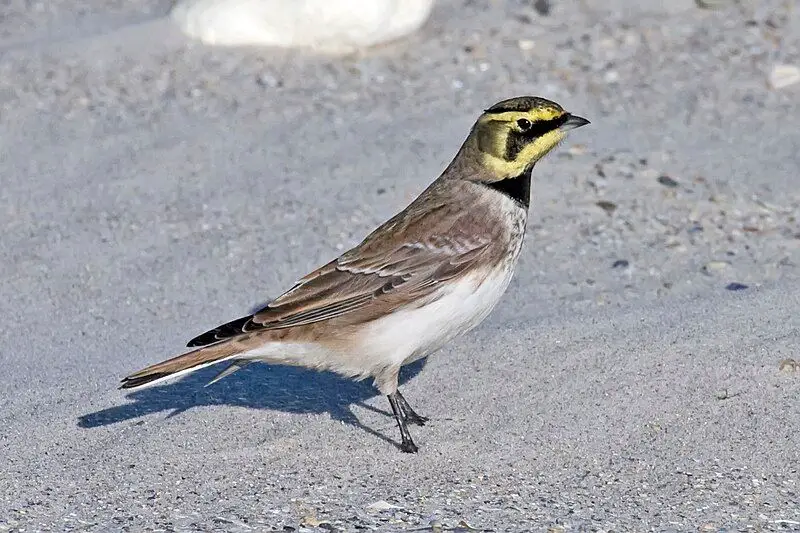
The Horned Lark is a small, ground-dwelling bird, measuring about 5.5-7 inches in length. It has a subtle, streaked brown and white plumage with a distinctive black “horn” or tuft of feathers on its head, which is more prominent in males during the breeding season.
Horned Larks are found in open habitats, including fields, grasslands, and tundra. They are known for their melodious, tinkling song and tinkling calls. These birds primarily feed on seeds, insects, and small invertebrates.
They are highly adaptable and can be seen in a range of environments, from Arctic tundra to deserts. During the breeding season, they build nests on the ground, often incorporating rocks and pebbles as camouflage.
Horned Larks are social birds, often seen in flocks, and are known for their agility in flight.
| Kingdom | Animalia |
| Phylum | Chordata |
| Clade | Dinosauria |
| Class | Aves |
| Order | Passeriformes |
| Family | Alaudidae |
| Genus | Eremophila |
| Species | E. alpestris |
47. White-Crowned Sparrow (Zonotrichia leucophrys)
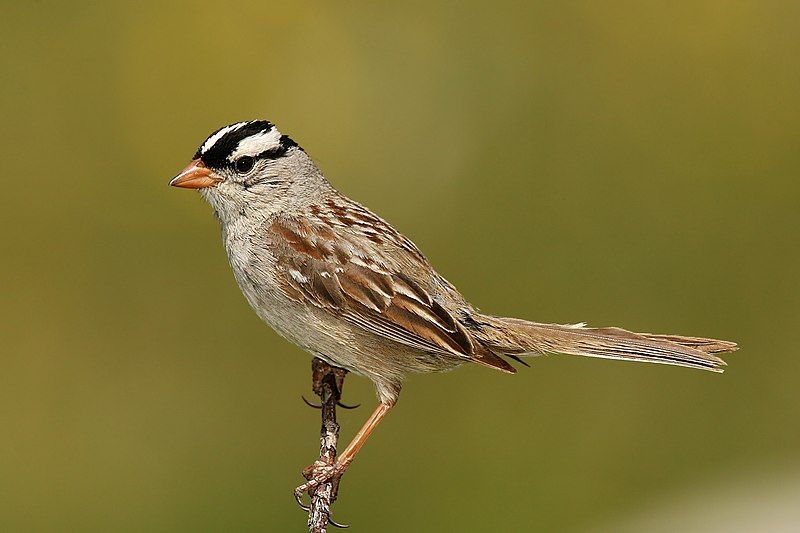
The White-Crowned Sparrow is a medium-sized sparrow, measuring about 6-7 inches in length. It has a striking appearance with a black and white striped crown, a gray face, and a pink or yellow bill.
The back is brown with streaks, and the underparts are grayish-white. These sparrows are known for their clear, whistled songs, with different variations across their range. They are often found in brushy habitats, gardens, and forest edges.
White-Crowned Sparrows primarily feed on seeds and insects, foraging on the ground and in low vegetation.
They are migratory birds, with populations breeding in North America and wintering in parts of the United States and Mexico. These sparrows are known for their distinctive behavior of “double-scratching,” where they use both feet to scratch the ground while foraging.
| Kingdom | Animalia |
| Phylum | Chordata |
| Clade | Dinosauria |
| Class | Aves |
| Order | Passeriformes |
| Family | Passerellidae |
| Genus | Zonotrichia |
| Species | Z. leucophrys |
48. Common Redpoll (Acanthis flammea)
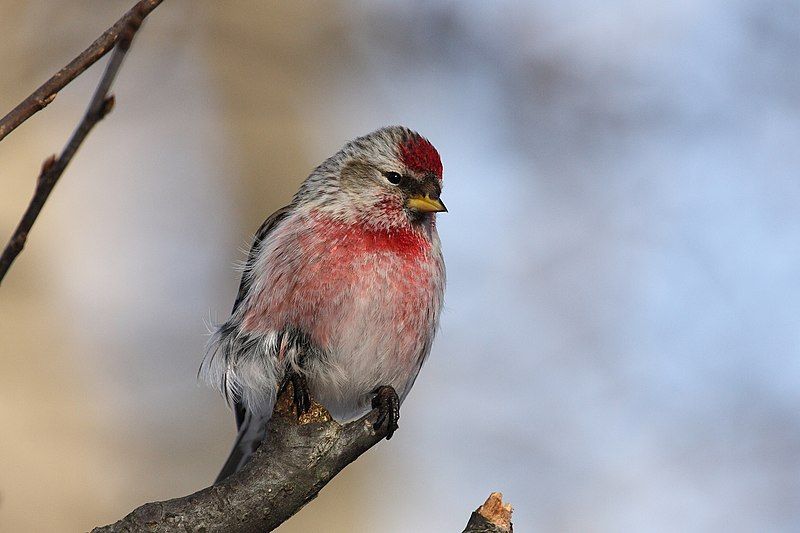
The Common Redpoll is a small finch, measuring about 4.3-5.1 inches in length. It has a streaked brown plumage with a distinctive red crown and a small black chin patch.
These finches are often seen in northern coniferous forests and tundra habitats, where they primarily feed on seeds, especially those of birch and alder trees.
Common Redpolls are known for their gentle, tinkling calls and songs. They are highly nomadic and irruptive, with their movements and abundance varying from year to year based on food availability.
These birds are often attracted to bird feeders, especially during harsh winter conditions when natural food sources are scarce.
Common Redpolls are resilient in cold climates and can fluff up their feathers to conserve heat. Their adaptability and vibrant plumage make them a delight to birdwatchers during the winter months
| Kingdom | Animalia |
| Phylum | Chordata |
| Clade | Dinosauria |
| Class | Aves |
| Order | Passeriformes |
| Family | Fringillidae |
| Genus | Acanthis |
| Species | A. flammea |
49. Common Grackle (Quiscalus quiscula)
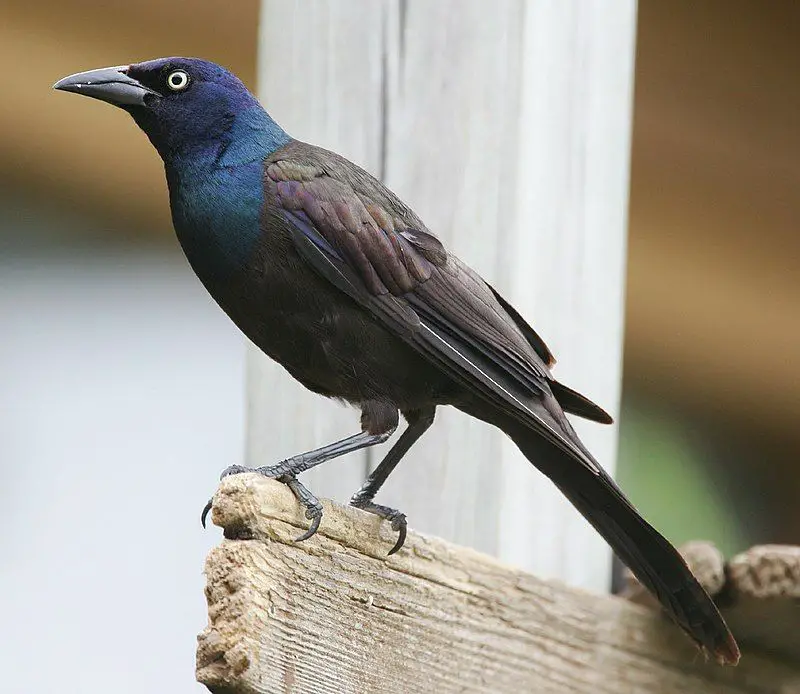
The Common Grackle is a medium-sized blackbird, measuring about 11-13 inches in length. It has a glossy black plumage with an iridescent greenish-blue sheen and striking yellow eyes. Males are slightly larger and have longer tails than females.
These birds are known for their harsh, creaking calls and songs, often described as a high-pitched “kee-ow.” Common Grackles are commonly found in a range of habitats, including woodlands, urban areas, and agricultural fields.
They primarily feed on insects, seeds, fruits, and small vertebrates, using their sharp bills to probe in soil and leaf litter.
These grackles are social birds, often seen in large flocks, especially during the non-breeding season. Their adaptability and gregarious nature make them a familiar sight in many parts of North America.
| Kingdom | Animalia |
| Phylum | Chordata |
| Clade | Dinosauria |
| Class | Aves |
| Order | Passeriformes |
| Family | Icteridae |
| Genus | Quiscalus |
| Species | Q. quiscula |
Conclusion
Winter birds in Connecticut play a crucial role in maintaining ecological balance and biodiversity in the region.
Despite the challenges they face during the cold winter months, these resilient avian species adapt and thrive by utilizing various survival strategies such as migration, territorial behavior, and finding food sources.
The presence of winter birds also brings joy and beauty to the lives of Connecticut residents, offering opportunities for birdwatching and connecting with nature even in the colder season.
It is essential to continue efforts in preserving and protecting the habitats and resources necessary for winter birds, ensuring their survival for future generations to admire and enjoy.